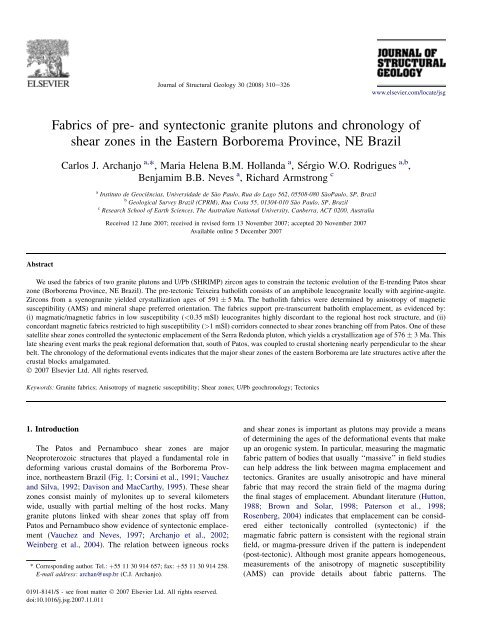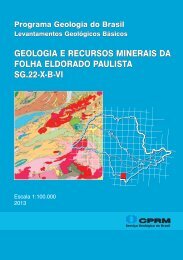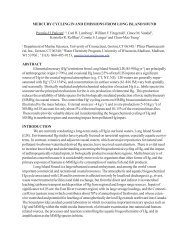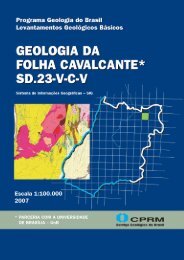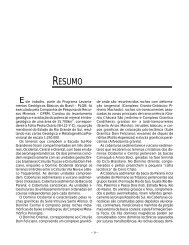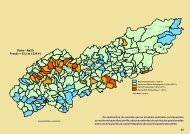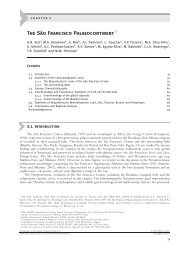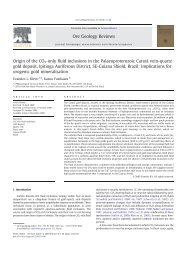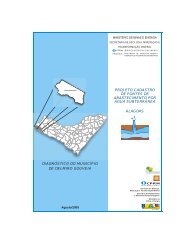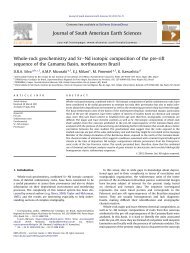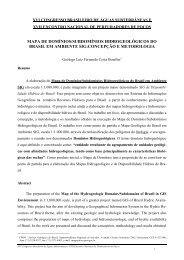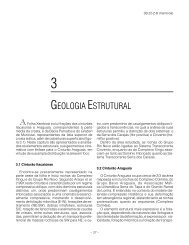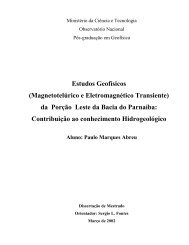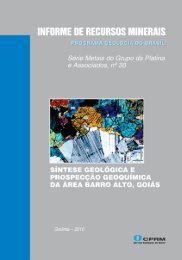Fabrics of pre- and syntectonic granite plutons and ... - CPRM
Fabrics of pre- and syntectonic granite plutons and ... - CPRM
Fabrics of pre- and syntectonic granite plutons and ... - CPRM
You also want an ePaper? Increase the reach of your titles
YUMPU automatically turns print PDFs into web optimized ePapers that Google loves.
Abstract<br />
<strong>Fabrics</strong> <strong>of</strong> <strong>pre</strong>- <strong>and</strong> <strong>syntectonic</strong> <strong>granite</strong> <strong>plutons</strong> <strong>and</strong> chronology <strong>of</strong><br />
shear zones in the Eastern Borborema Province, NE Brazil<br />
Carlos J. Archanjo a, *, Maria Helena B.M. Holl<strong>and</strong>a a ,Sérgio W.O. Rodrigues a,b ,<br />
Benjamim B.B. Neves a , Richard Armstrong c<br />
a Instituto de Geociências, Universidade de S~ao Paulo, Rua do Lago 562, 05508-080 S~aoPaulo, SP, Brazil<br />
b Geological Survey Brazil (<strong>CPRM</strong>), Rua Costa 55, 01304-010 S~ao Paulo, SP, Brazil<br />
c Research School <strong>of</strong> Earth Sciences, The Australian National University, Canberra, ACT 0200, Australia<br />
Received 12 June 2007; received in revised form 13 November 2007; accepted 20 November 2007<br />
Available online 5 December 2007<br />
We used the fabrics <strong>of</strong> two <strong>granite</strong> <strong>plutons</strong> <strong>and</strong> U/Pb (SHRIMP) zircon ages to constrain the tectonic evolution <strong>of</strong> the E-trending Patos shear<br />
zone (Borborema Province, NE Brazil). The <strong>pre</strong>-tectonic Teixeira batholith consists <strong>of</strong> an amphibole leuco<strong>granite</strong> locally with aegirine-augite.<br />
Zircons from a syeno<strong>granite</strong> yielded crystallization ages <strong>of</strong> 591 5 Ma. The batholith fabrics were determined by anisotropy <strong>of</strong> magnetic<br />
susceptibility (AMS) <strong>and</strong> mineral shape <strong>pre</strong>ferred orientation. The fabrics support <strong>pre</strong>-transcurrent batholith emplacement, as evidenced by:<br />
(i) magmatic/magnetic fabrics in low susceptibility (1 mSI) corridors connected to shear zones branching <strong>of</strong>f from Patos. One <strong>of</strong> these<br />
satellite shear zones controlled the <strong>syntectonic</strong> emplacement <strong>of</strong> the Serra Redonda pluton, which yields a crystallization age <strong>of</strong> 576 3 Ma. This<br />
late shearing event marks the peak regional deformation that, south <strong>of</strong> Patos, was coupled to crustal shortening nearly perpendicular to the shear<br />
belt. The chronology <strong>of</strong> the deformational events indicates that the major shear zones <strong>of</strong> the eastern Borborema are late structures active after the<br />
crustal blocks amalgamated.<br />
Ó 2007 Elsevier Ltd. All rights reserved.<br />
Keywords: Granite fabrics; Anisotropy <strong>of</strong> magnetic susceptibility; Shear zones; U/Pb geochronology; Tectonics<br />
1. Introduction<br />
The Patos <strong>and</strong> Pernambuco shear zones are major<br />
Neoproterozoic structures that played a fundamental role in<br />
deforming various crustal domains <strong>of</strong> the Borborema Province,<br />
northeastern Brazil (Fig. 1; Corsini et al., 1991; Vauchez<br />
<strong>and</strong> Silva, 1992; Davison <strong>and</strong> MacCarthy, 1995). These shear<br />
zones consist mainly <strong>of</strong> mylonites up to several kilometers<br />
wide, usually with partial melting <strong>of</strong> the host rocks. Many<br />
<strong>granite</strong> <strong>plutons</strong> linked with shear zones that splay <strong>of</strong>f from<br />
Patos <strong>and</strong> Pernambuco show evidence <strong>of</strong> <strong>syntectonic</strong> emplacement<br />
(Vauchez <strong>and</strong> Neves, 1997; Archanjo et al., 2002;<br />
Weinberg et al., 2004). The relation between igneous rocks<br />
* Corresponding author. Tel.: þ55 11 30 914 657; fax: þ55 11 30 914 258.<br />
E-mail address: archan@usp.br (C.J. Archanjo).<br />
0191-8141/$ - see front matter Ó 2007 Elsevier Ltd. All rights reserved.<br />
doi:10.1016/j.jsg.2007.11.011<br />
Journal <strong>of</strong> Structural Geology 30 (2008) 310e326<br />
www.elsevier.com/locate/jsg<br />
<strong>and</strong> shear zones is important as <strong>plutons</strong> may provide a means<br />
<strong>of</strong> determining the ages <strong>of</strong> the deformational events that make<br />
up an orogenic system. In particular, measuring the magmatic<br />
fabric pattern <strong>of</strong> bodies that usually ‘‘massive’’ in field studies<br />
can help address the link between magma emplacement <strong>and</strong><br />
tectonics. Granites are usually anisotropic <strong>and</strong> have mineral<br />
fabric that may record the strain field <strong>of</strong> the magma during<br />
the final stages <strong>of</strong> emplacement. Abundant literature (Hutton,<br />
1988; Brown <strong>and</strong> Solar, 1998; Paterson et al., 1998;<br />
Rosenberg, 2004) indicates that emplacement can be considered<br />
either tectonically controlled (<strong>syntectonic</strong>) if the<br />
magmatic fabric pattern is consistent with the regional strain<br />
field, or magma-<strong>pre</strong>ssure driven if the pattern is independent<br />
(post-tectonic). Although most <strong>granite</strong> appears homogeneous,<br />
measurements <strong>of</strong> the anisotropy <strong>of</strong> magnetic susceptibility<br />
(AMS) can provide details about fabric patterns. The
PARNAÍBA<br />
BASIN<br />
theoretical background <strong>of</strong> AMS is described elsewhere<br />
(Borradaile <strong>and</strong> Henry, 1997; Bouchez, 1997); the essence is<br />
that magnetic fabric provides a fast <strong>and</strong> accurate determination<br />
<strong>of</strong> the igneous structure <strong>of</strong> granitoids.<br />
The central <strong>and</strong> eastern segments <strong>of</strong> the Patos shear zone<br />
delimit two crustal blocks with different Neoproterozoic magmatic<br />
<strong>and</strong> kinematic histories. In the Seridó belt, located in the<br />
SeridóeJaguaribe domain north <strong>of</strong> the Patos shear zone<br />
(Fig. 1), porphyritic <strong>granite</strong>ediorite <strong>plutons</strong> have remarkably<br />
uniform magmatic fabrics parallel to the N- to NE-trending<br />
regional extension (Archanjo et al., 2002). This <strong>syntectonic</strong><br />
magmatism emplaced 580 5 Ma must record the peak<br />
regional deformation. In contrast, <strong>plutons</strong> south <strong>of</strong> Patos<br />
have different compositions <strong>and</strong> crystallization ages (Ferreira<br />
et al., 1998; Guimar~aes et al., 2004). The oldest granodiorite<br />
to tonalite <strong>plutons</strong> <strong>of</strong> about 630 <strong>and</strong> 610 Ma ages were<br />
emplaced before developing the transcurrent structures (Neves<br />
et al., 2006), <strong>and</strong> were likely related to a continental arc setting<br />
re<strong>pre</strong>sented by the Santa Quitéria Magmatic Arc (SQMA,<br />
Fig. 1; Fetter et al., 2003). This magmatism has not been found<br />
in the JaguaribeeSeridó domain, suggesting that the amalgamation<br />
<strong>of</strong> crustal blocks occurred late in the Borborema<br />
Province. A second magmatic event about 580 Ma consists<br />
<strong>of</strong> a porphyritic <strong>granite</strong> <strong>and</strong> diorite association similar to that<br />
described in the SeridóeJaguaribe domain. Its emplacement<br />
C.J. Archanjo et al. / Journal <strong>of</strong> Structural Geology 30 (2008) 310e326<br />
SÃO FRANCISCO<br />
CRATON<br />
0 200 km<br />
SQMA<br />
Senador Pompeu sz<br />
Fortaleza<br />
Pernambuco shear zone<br />
Patos sz<br />
Fig. 2<br />
Aracaju<br />
was coeval with strike-slip shearing in a bulk trans<strong>pre</strong>ssive<br />
setting (Neves et al., 2006). Finally, a late magmatic episode<br />
<strong>of</strong> Early Cambrian (545e530 Ma) <strong>granite</strong> <strong>plutons</strong> <strong>and</strong> subvolcanic<br />
dikes was related to a generalized episode <strong>of</strong> crustal<br />
extension.<br />
This paper focuses on the <strong>plutons</strong> <strong>of</strong> Teixeira <strong>and</strong> Serra<br />
Redonda, located just south <strong>of</strong> the Patos shear zone. It combines<br />
U/Pb SHRIMP zircon geochronology <strong>and</strong> AMS to constrain<br />
the timing <strong>of</strong> emplacement <strong>and</strong> its relation to the regional strain<br />
field. Magmatic <strong>and</strong> host rock fabrics allow us to postulate that<br />
the Patos <strong>and</strong> its satellite shear zones are late deformational<br />
structures that combined crustal-scale shearing <strong>and</strong> bulk regional<br />
shortening at a high angle to major faults.<br />
2. Geological setting<br />
Granite <strong>plutons</strong><br />
Seridó-Jaguaribe domain<br />
Fig. 1. Borborema Province (northeastern Brazil) highlighting the Brasiliano-Pan African plutonic rocks <strong>and</strong> shear zones. SQMA, Santa Quitéria Magmatic Arc.<br />
Natal<br />
Recife<br />
The central <strong>and</strong> eastern Patos <strong>and</strong> S~ao José dos Cordeiros<br />
shear zones enclose an ENE-trending corridor <strong>of</strong> Early Neoproterozoic<br />
rocks regionally called the Alto Pajeú belt (Fig. 2;<br />
Brito Neves et al., 2000). It consists <strong>of</strong> orthogneiss, intermediate<br />
to felsic metavolcanic <strong>and</strong> pelitic to psamitic metasediments<br />
between 1.1 <strong>and</strong> 0.9 Ga old (Brito Neves et al., 2001). Shear<br />
zones separate the Alto Pajeú belt from the Paleoproterozoic<br />
basement <strong>and</strong>, to the west, from Neoproterozoic low grade<br />
pelitic metasediments. The contact between the metapelites<br />
311
312 C.J. Archanjo et al. / Journal <strong>of</strong> Structural Geology 30 (2008) 310e326<br />
30 km<br />
Itaporanga<br />
Serrado Caboclo<br />
Juru shear zone<br />
<strong>and</strong> the Alto Pajeú belt occurs along the Serra do Caboclo<br />
mylonite zone, which joins the shear zones <strong>of</strong> Patos to the north<br />
<strong>and</strong> Juru to the south. The belt is limited to the east by the NEtrending<br />
Galante shear zone, which, approaching the Atlantic<br />
coast, joins the Patos mylonites. The Teixeira batholith <strong>and</strong><br />
Serra Redonda pluton are located along lithological contacts;<br />
between the metasedimentary rocks <strong>and</strong> orthogneisses <strong>of</strong> the<br />
Alto Pajeú belt <strong>and</strong> between the Early Neoproterozoic<br />
orthogneiss <strong>and</strong> the Paleoproterozoic basement, respectively.<br />
The shear zones that crosscut the Alto Pajeú Belt form<br />
a conjugate set, particularly well-developed around the <strong>plutons</strong><br />
<strong>of</strong> Campina Gr<strong>and</strong>e (Fig. 2). They consist <strong>of</strong> medium- to highgrade<br />
mylonites, usually with steep foliations <strong>and</strong> subhorizontal<br />
stretching lineations (Vauchez et al., 1995; Archanjo <strong>and</strong><br />
Fetter, 2004). Far from these mylonitic corridors, the foliation<br />
becomes anastomosed around lower strain rocks, some<br />
forming domes cored by <strong>granite</strong> <strong>plutons</strong> (Palmeira <strong>and</strong> Itapetim,<br />
Fig. 2). Some <strong>granite</strong> <strong>plutons</strong>, like Teixeira, Tabira, Serra<br />
Redonda <strong>and</strong> Queimadas, form elongated sheets parallel to the<br />
host regional foliation. The regional transcurrent structures<br />
overprint an older thrust fabric better recognized to the south<br />
<strong>of</strong> S~ao José dos Cordeiros shear zone (Neves et al., 2006). In<br />
Campina Gr<strong>and</strong>e, the development <strong>of</strong> the transcurrent fabric as<br />
well the metamorphic peak appears to be related to the<br />
emplacement <strong>of</strong> coarse porphyritic <strong>granite</strong>ediorite <strong>plutons</strong><br />
<strong>of</strong> Campina Gr<strong>and</strong>e (581 2 Ma, Guimar~aes et al., 2004)<br />
<strong>and</strong> Queimadas dike (570 24 Ma, Almeida et al., 2002).<br />
2.1. The Teixeira batholith<br />
Tabira<br />
The ENE-trending elongate Teixeira batholith, 80 km long<br />
<strong>and</strong> approximately 10 km wide, is an equigranular, leucocratic,<br />
<strong>granite</strong> to quartz-syenite in composition, except to the<br />
west in M~ae D’Agua in that it is porphyritic (Fig. 3). As its<br />
texture <strong>and</strong> mineralogy differ from the remaining batholith,<br />
we hereafter call it the M~ae D’Agua pluton. In map view,<br />
the pinch-<strong>and</strong>-swell shape <strong>of</strong> the batholith is related to the<br />
conjugate fractures <strong>and</strong> fault zones that crosscut the body.<br />
The two major necked regions allow to informally divide the<br />
Teixeira batholith to the west <strong>and</strong> east into the M~ae D’Agua<br />
pluton <strong>and</strong> the Jabre, Teixeira, S~ao Sebasti~ao <strong>and</strong> Pedra<br />
P<br />
Patos shear zone<br />
Teixeira<br />
I<br />
S. J. Cordeiros shear zone<br />
Sedimentary cover<br />
Brasiliano <strong>granite</strong>s<br />
Neoproterozoic metapelites<br />
Early Neoproterozoic rocks<br />
(Alto Pajeú Belt)<br />
Campina<br />
Gr<strong>and</strong>e<br />
Paleoproterozoic (> 2.0 Ga)<br />
basement<br />
Fig. 2. Structural sketch map between Patos <strong>and</strong> S~ao José dos Cordeiros <strong>and</strong> Juru shear zones <strong>and</strong> the distribution <strong>of</strong> <strong>granite</strong> <strong>plutons</strong> <strong>and</strong> satellite shear zones that<br />
crosscut the Alto Pajeú belt. E, Esperança; SR, Serra Redonda; Q, Queimadas; I, Itapetim; P, Palmeira.<br />
D’Agua domains, respectively (Fig. 3). The M~ae-D’Agua pluton<br />
consists <strong>of</strong> biotite <strong>and</strong> green hornblende porphyritic <strong>granite</strong>.<br />
Opaque grains are not visible in thin section. The Jabre <strong>and</strong><br />
Teixeira form roughly wedge-shaped domains limited by the<br />
Tendó shear zone. They consist <strong>of</strong> medium-grained biotiteamphibole<br />
monzo<strong>granite</strong> to syeno<strong>granite</strong>. Microstructure is<br />
magmatic to sub-magmatic (Bouchez et al., 1992), but near<br />
the southern contact with the host orthogneiss it develops<br />
a gneissic fabric. Opaque grains are not visible in thin sections<br />
within the Jabre <strong>and</strong> Teixeira domains, except close to sheared<br />
<strong>and</strong> fractured zones, where they usually occur with mafic<br />
minerals. The S~ao Sebasti~ao domain forms a roughly triangular<br />
body limited to the west <strong>and</strong> to the east, respectively, by the<br />
Guaritas fracture zone <strong>and</strong> the Itapetim shear zone (Fig. 3). It<br />
consists mostly <strong>of</strong> a medium-grained Fe-hastingsite syeno<strong>granite</strong>.<br />
Unlike the Jabre <strong>and</strong> Teixeira domains, opaque grains<br />
are visible in thin section, <strong>and</strong> biotite is absent or occurs<br />
locally as an accessory mineral. The microstructure is<br />
dominantly submagmatic, consisting <strong>of</strong> fractured feldspar<br />
plagioclase with tapered Carlsbad twins to locally gneissic<br />
consisting <strong>of</strong> elongate ribbons with finely recrystallized quartz<br />
<strong>and</strong> feldspar. Opaque grains are usually found with amphibole<br />
generally infilling internal micr<strong>of</strong>ractures. An aegirine-augite<br />
quartz syenite with blue amphibole occurs in the eastern border<br />
<strong>of</strong> the S~ao Sebasti~ao domain in contact with the Itapetim<br />
shear zone. The pyroxene shows a deep green pleochroism<br />
<strong>and</strong>, in contrast with the amphibole, has a large optical axial<br />
angle. Microstructure is submagmatic with pyroxene <strong>and</strong><br />
amphibole grains exhibiting a fairly good shape <strong>pre</strong>ferred<br />
orientation. The aegirine-augite quartz syenite is an equigranular,<br />
leucocratic body texturally similar to the S~ao Sebasti~ao,<br />
Teixeira <strong>and</strong> Jabre domains.<br />
Finally, the Pedra D’Agua domain consists <strong>of</strong> a set <strong>of</strong><br />
elliptical to elongate biotite-amphibole <strong>granite</strong> sheets located<br />
between the Itapetim <strong>and</strong> Taperoá shear zones (Fig. 3). Disrupted<br />
lenses <strong>of</strong> host rocks can be found between the <strong>granite</strong><br />
sheets that, approaching the eastern host rock contact, develop<br />
a ‘‘dactilict-type’’ structure consisting <strong>of</strong> alternating orthogneisses<br />
<strong>and</strong> <strong>granite</strong> dikes. The sheets are entirely foliated.<br />
The lineation, consisting <strong>of</strong> stretched mafic aggregates,<br />
plunges gently throughout. Since its gneissic fabric can be<br />
E<br />
Q<br />
SR
10 km<br />
Mãe<br />
D'Água<br />
S 1 L 1 S 2 L 2<br />
109 52 48 57<br />
Jabre<br />
porphyritic<br />
biotite > amphibole<br />
easily measured in the field, these sheets were not sampled for<br />
AMS.<br />
2.1.1. Country rocks structures <strong>and</strong> shear zone kinematics<br />
The batholith occupies the contact zone between Early<br />
Neoproterozoic metasediments <strong>and</strong> orthogneisses, but its eastern<br />
termination (Pedra D’Agua domain) is surrounded by<br />
orthogneiss. Further north, the metasediments are juxtaposed<br />
with Neoproterozoic metapelites by a sheared contact. The<br />
batholith pinches against retrogressed greenschist mylonites<br />
<strong>of</strong> the Patos shear zone. In the metapelite, the fabric is similar<br />
to that found along the Patos mylonites. It consists <strong>of</strong> a steeply<br />
dipping fanlike axial-plane foliation (S 1) transposing tight to<br />
isoclinal normal folds. Stretching <strong>and</strong> intersection lineations<br />
(L1) are normally subhorizontal <strong>and</strong> parallel to fold axes<br />
(Fig. 3). The same fabric style occurs to the south in the<br />
host orthogneiss. The gneissic foliation trends EeW to ENE<br />
<strong>and</strong> progressively bends to NE approaching the major<br />
mylonitic corridors <strong>of</strong> the Itapetim <strong>and</strong> Taperoá shear zones.<br />
These enclose the Pedra D’Agua domain to form sigma-type<br />
<strong>granite</strong> sheets consistent with the left-lateral movement <strong>of</strong><br />
NE-trending shear zones (Fig. 4). The foliation within the<br />
sheets is subvertical, parallel to the flattening plane formed<br />
by the left-lateral shear zones. A different fabric style marks<br />
the metasediments <strong>of</strong> the northern contact <strong>of</strong> the batholith.<br />
There, an asymmetric crenulation (D2) develops vertical folds<br />
with vergence to the east. An anastomosed to planar NEtrending<br />
foliation (S 2) dips steeply, while the lineation (L 2),<br />
C.J. Archanjo et al. / Journal <strong>of</strong> Structural Geology 30 (2008) 310e326<br />
Low-T Patos mylonite zone<br />
Teixeira<br />
Tendó shear zone Guaritas fracture zone<br />
ISZ<br />
TEIXEIRA BATHOLITH<br />
equigranular<br />
amphibole (±biotite)<br />
Specimen for zircon U/Pb Shrimp analysis<br />
São<br />
Sebastião<br />
Cacimbas<br />
equigranular<br />
aegirine-augite, amphibole<br />
TSZ<br />
defined by intersection surfaces (bedding S 1) <strong>and</strong> mineral<br />
alignment, usually plunges in a down-dip (Fig. 3).<br />
2.2. The Serra Redonda pluton<br />
Tertiary sediments<br />
Neoproterozoic (1.0 - 0.57 Ga)<br />
Pedra D'Água<br />
Granite<br />
Phylite <strong>and</strong> schist<br />
Metasediment, metavolcanic<br />
<strong>and</strong> orthogneiss<br />
Taperoá<br />
FIG. 4<br />
73 51<br />
Fig. 3. Structural map <strong>of</strong> the Teixeira batholith <strong>and</strong> host rocks. S, foliation pole; L, lineation. Schmidt stereogram, lower hemisphere. ISZ <strong>and</strong> TSZ correspond to,<br />
respectively, the Itapetim <strong>and</strong> Taperoá shear zones.<br />
The Serra Redonda pluton is an elongate intrusive body<br />
approximately 45 km long <strong>and</strong> 6 km wide, consisting <strong>of</strong> coarse<br />
porphyritic <strong>granite</strong> <strong>and</strong> diorite. The diorite occupies the eastern<br />
border <strong>of</strong> the pluton, either in contact with the SE-dipping<br />
Bacamarte thrust or as a small elongate stock in contact with<br />
the Galante shear zone. Near the contact the coarse porphyritic<br />
<strong>granite</strong> <strong>and</strong> diorite are converted to mylonite or protomylonite.<br />
The transcurrent Galante shear zone places the Paleoproterozoic<br />
basement against the Early Neoproterozoic <strong>and</strong> places<br />
the Serra Redonda in contact with the Campina Gr<strong>and</strong>e pluton.<br />
The latter is also composed <strong>of</strong> coarse porphyritic <strong>granite</strong> <strong>and</strong><br />
diorite, which led Almeida et al. (2002) to consider them a single<br />
magmatic body. The coarse texture <strong>and</strong> alignment <strong>of</strong><br />
feldspar phenocrysts allowed the magmatic foliation <strong>of</strong> these<br />
bodies to be mapped. The ‘‘teardrop’’ shape <strong>of</strong> the Campina<br />
Gr<strong>and</strong>e pluton shows concentric foliations dipping inward,<br />
while foliations in Serra Redonda are roughly parallel to the<br />
pluton elongation (Fig. 5, inset). Along the Galante shear<br />
zone, foliation is vertical. In the center <strong>and</strong> towards the eastern<br />
border, the foliation dips moderately to the SE. The magmatic<br />
lineation, usually <strong>pre</strong>served in the internal parts <strong>of</strong> the pluton,<br />
trends NE, parallel to the stretching direction <strong>of</strong> the Galante<br />
shear zone.<br />
TSZ<br />
S 1<br />
L 1<br />
313
314 C.J. Archanjo et al. / Journal <strong>of</strong> Structural Geology 30 (2008) 310e326<br />
Fig. 4. Satellite image <strong>of</strong> the eastern termination <strong>of</strong> the Teixeira batholith (Pedra D’Agua domain, see localization on Fig. 3). Note the sigma shape <strong>of</strong> the<br />
leuco<strong>granite</strong> sheets between Patos, Itapetim <strong>and</strong> Taperoá shear zone system.<br />
2.2.1. Country rocks structures <strong>and</strong> shear zone kinematics<br />
Host rock fabrics in the Campina Gr<strong>and</strong>e <strong>and</strong> Serra<br />
Redonda <strong>plutons</strong> vary in metamorphic degree <strong>and</strong> orientation.<br />
The foliation, generally parallel to gneissic b<strong>and</strong>ing <strong>of</strong> the<br />
Paleoproterozoic basement, dips moderately to the southeast<br />
in the eastern domain (Fig. 5). Down-dip lineations occur principally<br />
where b<strong>and</strong>ed gray gneisses are thrust over diorites.<br />
Quartz-feldspatic veins <strong>and</strong> melted pockets crosscutting the<br />
foliation <strong>of</strong> the hangingwall rocks attest to high temperature<br />
conditions. A few meters above the contact zone, diorite dikes<br />
cut the b<strong>and</strong>ed gneisses at a low to moderate angle. The dikes<br />
usually display a pinch-<strong>and</strong>-swell shape, while drag folds form<br />
in the wall rock foliation (Fig. 6). These features indicate that<br />
the dikes were emplaced in the final stages <strong>of</strong> the emplacement<br />
<strong>of</strong> Paleoproterozoic rocks over the <strong>granite</strong> footwall.<br />
The Paleoproterozoic basement <strong>and</strong> the Alto Pajeú belt are<br />
juxtaposed by the Galante shear zone, which, together with the<br />
Matinhas shear zone, forms the regional NE-trending sinistral<br />
branch <strong>of</strong> conjugate shear structures (Archanjo <strong>and</strong> Fetter,<br />
2004). These are characterized by low- to medium-grade<br />
steeply dipping mylonites. Stretching lineations are subhorizontal<br />
(Fig. 5). Between the Galante <strong>and</strong> Matinhas shear zones<br />
(northeast domain), the host rock foliation forms gentle to<br />
open folds distributed around a zone axis parallel to the<br />
subhorizontal NE-trending lineation. The foliation steepens<br />
progressively approaching the shear zones. Near the Queimadas<br />
dike to the south, the foliation <strong>and</strong> lineation, including the<br />
Galante shear zone, bend progressively to merge with the S~ao<br />
José dos Cordeiros shear zone (Fig. 2). Regional fabrics <strong>and</strong><br />
shear zone kinematics are consistent with a bulk NNWeSSE<br />
shortening direction, which, in addition could have caused<br />
the boudinage <strong>of</strong> the Queimadas dike. Because the magmatic<br />
fabric <strong>of</strong> the Serra Redonda pluton remains coaxial with the<br />
regional strain field, we conclude that the com<strong>pre</strong>ssive<br />
structures around Campina Gr<strong>and</strong>e were formed during or<br />
shortly after the emplacement <strong>of</strong> the pluton.<br />
2.3. U/Pb zircon geochronology<br />
We obtained U/Pb SHRIMP ages for two samples, a hornblende<br />
leuco<strong>granite</strong> from the Jabre domain (Teixeira batholith)<br />
<strong>and</strong> a porphyritic <strong>granite</strong> (Serra Redonda pluton). Samples were<br />
processed using a jaw crusher, wifley table, heavy liquids<br />
(brom<strong>of</strong>orm <strong>and</strong> methylene iodide) <strong>and</strong> a Frantz isodynamic<br />
separator at the Geochronology Research Center, University<br />
<strong>of</strong> S~ao Paulo. Re<strong>pre</strong>sentative zircon grains were h<strong>and</strong> picked<br />
under a binocular microscope, mounted in epoxy resin <strong>and</strong><br />
polished to approximately half their thickness to expose internal<br />
morphological features. Zircon st<strong>and</strong>ards were included in the<br />
mounts <strong>and</strong> analyzed sequentially with the unknowns. Transmitted<br />
<strong>and</strong> reflected light microscopy <strong>and</strong> cathodoluminescence<br />
imaging were taken for the selected zircon grains to determine<br />
internal complexities before analysis. The study focused on<br />
igneous growth sectors to obtain zircon crystallization ages.<br />
Analyses were performed on a SHRIMP II at the Research<br />
School <strong>of</strong> Earth Sciences (RSES) at the Australian National<br />
University, Canberra. The analytical procedure is detailed in<br />
Williams (1998). Data were collected <strong>and</strong> reduced as described<br />
by Williams <strong>and</strong> Claesson (1987) <strong>and</strong> Compston et al. (1992),<br />
using the SQUID Excel macro <strong>of</strong> Ludwig (2000). U/Pb ratios<br />
were referenced to the TEM st<strong>and</strong>ard (417 Ma), <strong>and</strong> U <strong>and</strong><br />
Th concentrations were determined with those measured in<br />
RSES zircon st<strong>and</strong>ard SL13. Correction for common Pb was<br />
made using measured 204 Pb <strong>and</strong> assuming the model Pb composition<br />
from Stacey <strong>and</strong> Kramers (1975). Errors in the isotopic<br />
ratios <strong>and</strong> ages are quoted in Table 1 at 1s errors. Concordia<br />
ages <strong>and</strong> statistical assessments were performed using the<br />
geochronological ISOPLOT/Excel 3.00 s<strong>of</strong>tware <strong>of</strong> Ludwig<br />
(2003); errors are given at the 95% confidence level.<br />
Zircons extracted from sample JAB1 (Teixeira batholith) are<br />
prismatic, from 150 to 250 mm in length <strong>and</strong> with variable<br />
aspect ratios. The color varies between clear, pinkish <strong>and</strong> light<br />
brown. All grains display typical primary oscillatory zoning;
Granite foliation poles<br />
Campina Gr<strong>and</strong>e Serra Redonda<br />
48 21<br />
N<br />
southern domain<br />
S: 88<br />
L: 60<br />
Campina<br />
Gr<strong>and</strong>e<br />
Fig. 6. Drag-fold in b<strong>and</strong>ed gneiss hosting a diorite dike. The b<strong>and</strong>ed gneiss<br />
forms the hanging wall rocks thrusted on porphyritic <strong>granite</strong> <strong>and</strong> diorite <strong>of</strong><br />
the Serra Redonda pluton. The feature suggest the dike crosscut the gneissic<br />
b<strong>and</strong>ing in the latest ductile stage <strong>of</strong> the thrust movement.<br />
8 km<br />
Serra Redonda pluton Host regional rocks<br />
eastern domain<br />
porphyritic <strong>granite</strong> orthogneiss (Early Neoproterozoic)<br />
diorite<br />
C.J. Archanjo et al. / Journal <strong>of</strong> Structural Geology 30 (2008) 310e326<br />
MSZ<br />
Specimen for zircon U/Pb Shrimp analysis<br />
Matinhas shear zone<br />
(MSZ)<br />
S: 137<br />
L: 104<br />
GSZ<br />
NE domain<br />
Paleoproterozoic basement<br />
S: 129<br />
L: 74<br />
Galante shear zone<br />
(GSZ)<br />
Fig. 5. Structural map <strong>of</strong> the Campina Gr<strong>and</strong>e Magmatic Complex <strong>and</strong> country rocks. In the orientation stereograms the foliation pole (S, shaded area) <strong>and</strong><br />
lineation (L) are shown on Schmidt net (lower hemisphere). Inset: the planar magmatic fabric <strong>of</strong> Campina Gr<strong>and</strong>e <strong>and</strong> Serra Redonda <strong>plutons</strong>. MSZ <strong>and</strong> GSZ<br />
correspond to, respectively, the Matinhas <strong>and</strong> Galante shear zones.<br />
S: 177<br />
L: 141<br />
S: 60<br />
L: 44<br />
some <strong>of</strong> them show a crosscutting relationship with a second,<br />
later, magmatic domain. Cores occur in most <strong>of</strong> the grains.<br />
These are rounded in shape; generally, complex internal structures<br />
are absent. Radial micr<strong>of</strong>ractures from the cores are also<br />
<strong>pre</strong>sent, probably induced by metamictization-related volume<br />
expansion <strong>of</strong> the crystal lattice (e.g. Lee <strong>and</strong> Tromp, 1995).<br />
Fifteen analyses were performed on different zircon grains<br />
(Table 1) <strong>and</strong> plotted on a conventional Wetherill U/Pb Concordia<br />
diagram (Fig. 7). Eight analyses are significantly discordant,<br />
<strong>and</strong> were excluded from the age calculation. Two analyses<br />
(spots #11, #15) with high 207 *Pb/ 206 *Pb ages, are attributed<br />
to inherited, old zircons. The five remaining analyses (spots<br />
#1, #3, #4, #5, #6) define a Concordia age <strong>of</strong> 591 5.3 Ma,<br />
the best estimate for crystallization <strong>of</strong> the Teixeira pluton.<br />
Zircons extracted from the Serra Redonda pluton (sample<br />
SR1) are prismatic <strong>and</strong> euhedral, between 200 to 300 mm in<br />
length. The color varies from pinkish to light brown. CL images<br />
reveal typical magmatic oscillatory zoning. Eighteen zircon<br />
grains were dated (see Table 1). Most <strong>of</strong> the analytical points<br />
315
Table 1<br />
U/Pb SHRIMP isotopic data on zircons from the Teixeira <strong>and</strong> Serra Redonda <strong>granite</strong> <strong>plutons</strong> (NE Brazil)<br />
Grain<br />
Spot<br />
% 206Pbc<br />
U ppm Th<br />
ppm<br />
232 Th/<br />
238 U<br />
206 Pb*<br />
ppm<br />
206 Pb/ 238 U<br />
Age a<br />
207 Pb/ 206 Pb<br />
Age a<br />
%<br />
Discor<br />
dant<br />
Total<br />
238 U/<br />
206 Pb<br />
% Total<br />
207 Pb/<br />
206 Pb<br />
% 238 U/<br />
206 Pb a<br />
% 207 Pb*/<br />
206 Pb* a<br />
Teixeira<br />
1.1 0.26 695 158 0.24 58.1 596.7 3.9 597 20 0 10.285 0.68 0.06195 0.54 10.312 0.68 0.05983 0.92 0.8 1.1 0.09698 0.68 0.596<br />
2.1 0.52 603 270 0.46 48.7 576.4 3.9 596 25 3 10.637 0.71 0.064 0.58 10.692 0.71 0.05979 1.1 0.771 1.3 0.09353 0.71 0.528<br />
3.1 0.53 832 225 0.28 69.3 593.6 3.9 625 22 5 10.313 0.68 0.0649 0.59 10.367 0.68 0.0606 1 0.806 1.2 0.09646 0.68 0.552<br />
4.1 0.94 837 170 0.21 69.2 587.1 4.6 598 38 2 10.389 0.8 0.06751 0.47 10.488 0.81 0.0599 1.7 0.787 1.9 0.09535 0.81 0.423<br />
5.1 0.61 902 180 0.21 73.7 582.7 4.4 654 21 11 10.507 0.78 0.06634 0.46 10.571 0.78 0.06141 10 0.801 1.3 0.0946 0.78 0.616<br />
6.1 0.20 487 87 0.19 40 587.2 4 599 31 2 10.464 0.7 0.06152 1.2 10.485 0.7 0.05987 1.4 0.787 1.6 0.09537 0.7 0.437<br />
7.1 3.53 1053 787 0.77 85.2 560.6 4.6 576 49 3 10.618 0.82 0.08804 0.67 11.007 0.86 0.0592 2.2 0.742 2.4 0.09085 0.86 0.358<br />
8.1 4.89 1017 502 0.51 81.4 547.7 3.9 523 70 5 10.727 0.67 0.0977 1.1 11.278 0.75 0.0578 3.2 0.707 3.3 0.08867 0.75 0.229<br />
9.1 2.63 1040 800 0.79 70.8 478.9 3.3 536 82 11 12.626 0.67 0.0795 2 12.967 0.71 0.0582 3.8 0.619 3.8 0.07712 0.71 0.186<br />
10.1 2.15 518 152 0.30 38.2 520.9 5.9 623 79 16 11.63 1.1 0.0779 1.9 11.88 1.2 0.0605 3.7 0.702 3.8 0.08416 1.2 0.305<br />
11.1 2.90 926 247 0.28 198 1396.9 9.5 1910 31 27 4.013 0.71 0.1409 0.96 4.133 0.75 0.117 1.8 3.902 1.9 0.242 0.75 0.395<br />
12.1 6.48 1758 977 0.57 128 492.5 5.4 640 320 23 11.78 0.65 0.1134 4.6 12.6 1.1 0.061 15 0.668 15 0.07939 1.1 0.078<br />
13.1 1.49 894 223 0.26 71.9 569 3.7 636 45 11 10.676 0.67 0.07302 1.3 10.837 0.69 0.0609 2.1 0.775 2.2 0.09228 0.69 0.313<br />
14.1 3.82 836 377 0.47 66.9 553.2 3.9 566 57 2 0.14 0.68 0.09013 0.73 11.161 0.73 0.059 2.6 0.729 2.7 0.0896 0.73 0.271<br />
15.1 1.02 522 118 0.23 53 714.1 7.7 1276 86 44 8.449 1.1 0.0915 3.9 8.536 1.1 0.0833 4.4 1.345 4.5 0.1171 1.1 0.252<br />
Serra Redonda<br />
1.1 0.22 408 208 0.53 33.3 584.2 4 578 23 1 10.52 0.72 0.06109 0.71 10.543 0.72 0.0593 1.1 0.7756 1.3 0.09485 0.72 0.565<br />
2.1 0.15 456 251 0.57 36.7 576.6 4 575 20 0 10.671 0.73 0.06046 0.68 10.688 0.73 0.05921 0.91 0.7639 1.2 0.09357 0.73 0.628<br />
3.1 0.19 488 258 0.55 39.1 573.9 3.9 581 22 1 10.721 0.7 0.06092 0.65 10.741 0.71 0.05939 1 0.7624 1.2 0.0931 0.71 0.571<br />
4.1 0.00 438 243 0.57 36.8 601.1 4.2 616 15 2 10.233 0.74 0.06034 0.7 10.233 0.74 0.06034 0.7 0.8131 1 0.09772 0.74 0.724<br />
5.1 0.05 595 412 0.72 47.5 572.3 3.9 591 23 3 10.765 0.7 0.0601 0.98 10.771 0.7 0.05966 1.1 0.7637 1.3 0.09284 0.7 0.554<br />
6.1 0.14 374 194 0.53 30.2 578.6 4 599 20 3 10.635 0.72 0.06101 0.73 10.65 0.72 0.05986 0.93 0.775 1.2 0.0939 0.72 0.616<br />
7.1 1.30 631 334 0.55 50.6 567.6 3.8 570 52 0 10.724 0.68 0.06965 0.99 10.865 0.7 0.0591 2.4 0.75 2.5 0.09204 0.7 0.282<br />
8.1 0.42 535 265 0.51 42.9 572.3 4.9 598 25 4 10.725 0.88 0.06332 0.6 10.771 0.89 0.05986 1.1 0.766 1.4 0.09284 0.89 0.615<br />
9.1 0.22 539 301 0.58 43.7 580.8 3.9 568 21 2 10.583 0.69 0.06086 0.61 10.607 0.7 0.05903 0.94 0.7673 1.2 0.09428 0.7 0.594<br />
10.1 0.34 478 270 0.58 38.5 575.2 3.9 528 28 9 10.678 0.71 0.06076 0.67 10.715 0.71 0.05795 1.3 0.746 1.4 0.09333 0.71 0.492<br />
11.1 0.10 567 296 0.54 45 569 3.9 592 18 4 10.825 0.71 0.06052 0.69 10.837 0.71 0.05968 0.82 0.7593 1.1 0.09228 0.71 0.654<br />
12.1 0.02 491 259 0.54 39.3 573.8 3.8 596 14 4 10.739 0.7 0.05995 0.63 10.741 0.7 0.05979 0.66 0.7675 0.96 0.0931 0.7 0.727<br />
13.1 0.13 522 249 0.49 42.1 577.7 4 597 22 3 10.653 0.71 0.06085 0.62 10.667 0.72 0.05981 1 0.773 1.2 0.09375 0.72 0.581<br />
14.1 0.23 503 267 0.55 41 582.9 4 579 30 1 10.543 0.72 0.0612 1.1 10.568 0.72 0.05933 1.4 0.774 1.5 0.09463 0.72 0.468<br />
15.1 0.14 458 236 0.53 36.5 571.7 4.9 586 24 2 10.768 0.9 0.06067 0.67 10.783 0.9 0.05953 1.1 0.761 1.4 0.09273 0.9 0.631<br />
16.1 0.14 522 275 0.54 41.6 572.1 5.4 596 23 4 10.76 0.98 0.06093 0.63 10.77 0.99 0.05979 1 0.765 1.4 0.09281 0.99 0.687<br />
17.1 0.17 587 353 0.62 45.9 560.6 5.2 582 26 4 10.99 0.96 0.06082 0.6 11.01 0.96 0.05942 1.2 0.744 1.5 0.09085 0.96 0.628<br />
18.1 0.15 462 229 0.51 36.2 562 3.8 584 26 4 10.962 0.71 0.06072 0.98 10.979 0.71 0.05946 1.2 0.747 1.4 0.09109 0.71 0.508<br />
Errors are 1-sigma; Pbc <strong>and</strong> Pb* indicate the common <strong>and</strong> radiogenic portions, respectively. Error in St<strong>and</strong>ard calibration was 0.23% (not included in above errors but required when comparing data from different<br />
mounts).<br />
a 204<br />
Common Pb corrected using measured Pb.<br />
%<br />
207 Pb*/<br />
235 U a<br />
%<br />
206 Pb*/<br />
238 U a<br />
% err.<br />
corr<br />
316 C.J. Archanjo et al. / Journal <strong>of</strong> Structural Geology 30 (2008) 310e326
Fig. 7. Wetheril U/Pb concordia diagram for a hornblende leuco<strong>granite</strong> from<br />
the Teixeira batholith (A) <strong>and</strong> for a porphyritic syeno<strong>granite</strong> from the Serra<br />
Redonda pluton (B; see localization on Figs. 3 <strong>and</strong> 5). The discordant data re<strong>pre</strong>sented<br />
by unshaded ellipses were not included in the concordia age calculations.<br />
For the diagrams, the data-point error ellipses are plotted with 1s errors.<br />
cluster near the Concordia curve, with just one older, probably<br />
inherited grain (spot #4), with a relatively high 206 *Pb/ 238 Pb<br />
ratio. A weighted 206 */Pb/ 238 Pb mean date for fifteen zircons,<br />
after excluding three discordant analyses (spots #4, #17, #18),<br />
yielded an age <strong>of</strong> 575.4 2.1 Ma (MSWD ¼ 1.45; probability<br />
¼ 0.12). This age is indistinguishable from the Concordia<br />
age <strong>of</strong> 576 3.1 Ma calculated without spots #4 <strong>and</strong> #18<br />
(Fig. 7).<br />
3. Anisotropy <strong>of</strong> magnetic susceptibility <strong>of</strong> the<br />
Teixeira batholith<br />
3.1. Sampling <strong>and</strong> AMS determination<br />
AMS was applied only in the Teixeira batholith as its massive,<br />
equigranular microstructure made it extremely difficult to<br />
C.J. Archanjo et al. / Journal <strong>of</strong> Structural Geology 30 (2008) 310e326<br />
determine its magmatic fabric using st<strong>and</strong>ard field measurements.<br />
The technique consists <strong>of</strong> measuring the magnetic<br />
susceptibility (k) <strong>of</strong> a rock in different directions <strong>and</strong> defining<br />
the magnitude (intensity <strong>and</strong> orientation) <strong>of</strong> the three principal<br />
axes k1 k2 k3. We measured the AMS <strong>of</strong> 554 specimens<br />
from 129 sites from the M~ae D’Agua pluton to the Itapetim<br />
shear zone (Fig. 8). Some regions to the west <strong>and</strong> south <strong>of</strong><br />
M~ae D’Agua were not sampled due to problems with access.<br />
In M~ae D’Agua, Jabre <strong>and</strong> Teixeira, we studied 49 (12 sites),<br />
108 (33 sites) <strong>and</strong> 172 (36 sites) specimens, respectively. In<br />
the S~ao Sebasti~ao domain, which includes the aegirine-augite<br />
quartz syenite, we studied a total <strong>of</strong> 225 specimens (48 sites)<br />
<strong>of</strong> which 55 (14 sites) were <strong>of</strong> the quartz syenite. Included in<br />
the S~ao Sebasti~ao domain are 24 specimens (6 sites) just to the<br />
east <strong>of</strong> the Itapetim shear zone. At each site, we extracted two<br />
or three cylindrical cores nearly 7 cm <strong>of</strong> length <strong>and</strong> 2.5 cm <strong>of</strong><br />
diameter with a portable gasoline-powered rock drill. The<br />
cores were oriented in place with a magnetic compass. In<br />
the laboratory, each cylindrical core was cut to produce two<br />
2.2-cm-long specimens, so the AMS parameters (tensor magnitudes<br />
<strong>and</strong> directions) <strong>of</strong> each site are characterized by four to<br />
five specimens. Low-field AMS was measured in a KLY-2<br />
Kappabridge device (AGICO) in the Laboratório de Propriedades<br />
Físicas de Materiais Geológicos (Natal, UFRN).<br />
Specimen susceptibility <strong>and</strong> its normalized tensor principal<br />
directions were calculated using the Jelinek (1981) protocol.<br />
Table 2 shows the average-site AMS parameters<br />
(K1 K2 K3) <strong>of</strong> the batholith (small caps symbols designate<br />
AMS specimen parameters). The symmetry <strong>of</strong> the magnetic<br />
fabric is re<strong>pre</strong>sented by the T factor ex<strong>pre</strong>ssed by<br />
T ¼ [2(lnK2 lnK3)/(lnK1 lnK3] 1. T ¼ 1 are for<br />
prolate ellipsoids (K1 > K2 ¼ K3) <strong>and</strong> T ¼ 1 are for oblate<br />
ellipsoids (K 1 ¼ K 2 > K 3). Neutral or triaxial ellipsoids have<br />
T ¼ 0(K 1 > K 2 > K 3). The degree <strong>of</strong> anisotropy is indicated<br />
by P ¼ K 1/K 3, which ranges from one (isotropic) to higher<br />
values.<br />
3.2. Low-field magnetic susceptibility data<br />
The magnetic susceptibility (k) <strong>of</strong> the porphyritic <strong>granite</strong> <strong>of</strong><br />
M~ae D’Agua (0.11 mSI, st.dev., 0.02) <strong>and</strong> the aegirine-augite<br />
quartz syenite (6.22, st.dev, 5.92) shows a dominant unimodal<br />
distribution, while the Jabre, Teixeira <strong>and</strong> S~ao Sebasti~ao<br />
domains have a bimodal distribution (Fig. 9). The contrasting<br />
values <strong>of</strong> k in the porphyritic <strong>and</strong> aegirine-augite quartz syenite<br />
are typical <strong>of</strong> the paramagnetic <strong>and</strong> ferromagnetic <strong>granite</strong><br />
series, respectively (Ishihara, 1977). The dominant ferromagnetic<br />
mineral in <strong>granite</strong>s is usually magnetite, while in the<br />
paramagnetic <strong>granite</strong>s most <strong>of</strong> the susceptibility contribution<br />
comes from Fe/Mg silicates. This agrees with the rock content<br />
<strong>of</strong> opaque grains in the Teixeira batholith, absent in thin<br />
sections <strong>of</strong> the M~ae D’Agua porphyritic <strong>granite</strong> <strong>and</strong> common<br />
in the aegirine-augite quartz syenite. k shows a bimodal<br />
distribution in the equigranular <strong>granite</strong>s <strong>of</strong> Jabre, Teixeira<br />
<strong>and</strong> S~ao Sebasti~ao, peaking between 0.10 <strong>and</strong> 0.30 mSI <strong>and</strong><br />
between >1 <strong>and</strong> 10 mSI. The highest k values occur when<br />
opaque grains are visible in thin section. In addition, there is<br />
317
318 C.J. Archanjo et al. / Journal <strong>of</strong> Structural Geology 30 (2008) 310e326<br />
Mãe D'Água<br />
a clear relation between k > 1 mSI <strong>and</strong> the shear <strong>and</strong> fracture<br />
zones that crosscut the batholith (Fig. 9). k < 0.25 mSI is<br />
typical in the Jabre <strong>and</strong> Teixeira domains <strong>and</strong> increases<br />
approaching the Tendó <strong>and</strong> Guaritas fracture zones. Close to<br />
the Itapetim shear zone, k can reach values >10 mSI. In the<br />
same way, the degree <strong>of</strong> anisotropy (P ¼ k 1/k 3) increases to<br />
the east from the M~ae D’Agua pluton (P ¼ 1.02; st.dev.<br />
0.01) to Jabre (1.06; 0.03), Teixeira (1.07; 0.06) <strong>and</strong> S~ao<br />
Sebasti~ao (1.08; 0.05) (Table 1); in the fracture <strong>and</strong> shear<br />
zones anisotropy reaches its highest magnitudes (1.11 to 1.13).<br />
The magnetic mineralogy <strong>of</strong> the Teixeira batholith is<br />
detailed in Lima et al. (2000). Thermomagnetic data coupled<br />
with backscattered electron microscopy investigations show<br />
Ti-poor magnetite as the dominant ferromagnetic oxide. Hysteresis<br />
ratios <strong>of</strong> 19 specimens with a k > 0.35 mSI plot on Day<br />
et al. (1977) plot on the right side <strong>of</strong> the pseudodomain field.<br />
Grains with this hysteresis ratio may correspond to mixtures <strong>of</strong><br />
ferromagnetic particles with different susceptibilities <strong>and</strong>/or<br />
coercivity values (Dunlop, 2002). Mixtures <strong>of</strong> magnetite <strong>and</strong><br />
hematite are probable c<strong>and</strong>idates for the high remanent<br />
coercivity values <strong>of</strong> some specimens. Hematite was observed<br />
locally in small isolated grains or partially replacing magnetite<br />
(Lima et al., 2000). Results indicated that the regional variation<br />
<strong>of</strong> k <strong>and</strong> P depends mainly on the amount <strong>of</strong> magnetite,<br />
<strong>and</strong> is spatial related with the faulted <strong>and</strong> fractured zones<br />
within the batholith. The oxide contents as well the k values<br />
decrease far from the deformed zones, suggesting a secondary<br />
origin for the magnetite <strong>and</strong> hematite grains.<br />
3.3. Magnetic fabric<br />
10 km<br />
Jabre Teixeira<br />
When we examine the magnetic lineations <strong>and</strong> foliations,<br />
two contrasting fabric styles become apparent. Foliations dip<br />
moderately to steeply (>45 ; shaded area in Fig. 10) along<br />
the southern contact, close to the necked zone <strong>of</strong> M~ae<br />
D’Agua, along the Itapetim shear zone <strong>and</strong> at the intersection<br />
<strong>of</strong> the Tendó <strong>and</strong> Guaritas fracture zones. The corresponding<br />
lineation plunges gently mostly to the east (mean lineation:<br />
083,11). The magnetic fabric <strong>of</strong> the ‘‘batholith parallel’’ structures<br />
shows a different orientation. The magnetic foliation dips<br />
São Sebastião<br />
Cacimbas<br />
ISZ<br />
gently (Jabre <strong>and</strong> Teixeira) or moderately (M~ae D’Agua, S~ao<br />
Sebasti~ao), while the lineation is transverse to the batholith<br />
elongation (mean lineation: 341,2). Furthermore, in the Jabre<br />
<strong>and</strong> Teixeira domains the foliation forms gentle basin- <strong>and</strong><br />
dome-like structures, respectively. In S~ao Sebasti~ao, the<br />
magnetic fabric is nearly transverse to the batholith elongation,<br />
but approaching the Itapetim shear zone it progressively<br />
bends to become parallel to the stretching direction formed by<br />
the Itapetim <strong>and</strong> Taperoá shear zone system.<br />
The transition <strong>of</strong> the magnetic fabric, especially the<br />
lineation, occurs from west to east along the batholith<br />
(Fig. 10). The M~ae D’Agua pluton <strong>and</strong> Jabre-Teixeira domains<br />
show dominant NW- <strong>and</strong> N-trending lineations. Two sets <strong>of</strong><br />
orthogonal lineations occur in the S~ao Sebasti~ao <strong>and</strong> Cacimbas<br />
domains <strong>and</strong> foliation rotates from NW-trending to E-trending<br />
approaching the Itapetim shear zone.<br />
3.4. Significance <strong>of</strong> magnetic fabric<br />
AMS samples sites<br />
station<br />
thermomagnetic data<br />
hysteresis data<br />
Fig. 8. Sites <strong>of</strong> anisotropy <strong>of</strong> magnetic susceptibility (AMS) measurements in the Teixeira batholith. The distribution <strong>of</strong> sites with thermomagnetic <strong>and</strong> hysteresis<br />
data published by Lima et al. (1999) is also indicated. Dashed lines correspond to the contact <strong>of</strong> hornblende <strong>granite</strong> <strong>and</strong> aegirine-augite quartz syenite. ISZ,<br />
Itapetim shear zone. The foliation trajectories in the Pedra D’Agua domain (PD, not sampled to AMS) are shown by thin lines. Shaded lines to the west <strong>of</strong><br />
ISZ correspond to the main fracture <strong>and</strong> fault zones within the batholith.<br />
The relation between magnetic <strong>and</strong> mineral fabric directions<br />
in two cross-sections where they are highly discordant<br />
to the batholith elongation were studied by image analysis.<br />
3-D mineral shape <strong>pre</strong>ferred orientation (SPO) was determined<br />
by combining fabric data from three mutually orthogonal 2-D<br />
rock sections (Robin, 2002), <strong>and</strong> the results were compared to<br />
AMS. Implementations <strong>and</strong> applications <strong>of</strong> this technique can<br />
be found in Launeau <strong>and</strong> Robin (2005).<br />
The study <strong>of</strong> the <strong>pre</strong>ferred orientation <strong>of</strong> mafic minerals<br />
concerned five sites along the Jabre <strong>and</strong> four along Teixeira<br />
cross-sections (Fig. 11). Field oriented rock blocks <strong>of</strong> c.<br />
10 cm dimensions <strong>and</strong> small quarries mined for pavement<br />
<strong>and</strong> local home constructions were used. The blocks were<br />
cut into three perpendicular sections <strong>and</strong> each face carefully<br />
oriented. After cleaning each block section or quarry face,<br />
high-resolution digital images were taken <strong>and</strong> later transferred<br />
to a microcomputer for treatment <strong>and</strong> mineral classification.<br />
Dark minerals are readily isolated from the leucocratic<br />
quartz-feldspar by threshold. The resulting binary image is improved<br />
by smoothing filters, which remove misclassified pixels<br />
PD
C.J. Archanjo et al. / Journal <strong>of</strong> Structural Geology 30 (2008) 310e326<br />
Table 2<br />
Anisotropy <strong>of</strong> magnetic susceptibility parameters <strong>of</strong> the Teixeira batholith<br />
Site Km (mSI) P T Kl K3 M~ae D’Agua<br />
10 0.010 1.021 0.68 315,42 (25.6) 073,27 (14.4)<br />
11 0.140 1.013 0.31 209,2 (21.1) 117,37 (28.0)<br />
127 0.112 1.023 0.05 320,9 (14.6) 210,6 (63.6)<br />
128 0.112 1.021 0.39 145,1 (33.2) 057,28 (11.8)<br />
129 0.100 1.015 0.17 327,6 (11.5) 064,68 (14.4)<br />
130 0.093 1.027 0.05 329,7 (20.4) 158,82 (18.5)<br />
131 0.091 1.017 0.13 151,5 (18.9) 050,62 (39.9)<br />
132 0.114 1.014 0.38 263,34 (60.1) 352,32 (43.5)<br />
133 0.090 1.016 0.48 336,7 (22.4) 104,77 (20.9)<br />
134 0.084 1.033 0.25 326,2 (32.0) 064,45 (26.5)<br />
137 0.095 1.020 0.17 332,5 (16.2) 066,41 (15.3)<br />
138 0.092 1.017 0.23 178,6 (60.6) 071,48 (35.9)<br />
Jabre<br />
01 0.391 1.080 0.45 053,8 (23.4) 138,14 (45.6)<br />
31 0.157 1.035 0.39 001,7 (24.0) 102,55 (7.5)<br />
38 0.153 1.031 0.82 346,25 (48.7) 139,56 (21.8)<br />
39 0.138 1.041 0.98 117,6 (49.7) 354,79 (3.4)<br />
40 0.087 1.049 0.42 005,12 (16.8) 270,79 (3.4)<br />
42 0.156 1.048 0.50 341,9 (10.3) 160,81 (10.8)<br />
43 0.900 1.067 0.19 098,8 (23.4) 002,36 (45.3)<br />
44 0.140 1.033 0.59 115,6 (25.5) 306,86 (14.5)<br />
45 0.146 1.042 0.38 174,8 (10.8) 294,73 (7.1)<br />
47 0.130 1.051 0.64 340,18 (7.7) 119,67 (3.2)<br />
53 1.852 1.078 0.40 250,1 (21.9) 155,70 (6.7)<br />
54 0.129 1.041 0.65 003,4 (23.2) 113,77 (4.6)<br />
55 0.133 1.046 0.37 358,21 (12.8) 167,69 (8.5)<br />
56 0.116 1.039 0.76 307,14 (54.5) 170,75 (24.3)<br />
60 1.480 1.048 0.17 002,32 (39.8) 247,37 (34.2)<br />
61 1.099 1.091 0.62 194,1 (33.2) 094,84 (5.4)<br />
62 0.167 1.038 0.55 171,12 (24.9) 032,74 (11.1)<br />
63 0.120 1.035 0.71 191,9 (12.4) 019,81 (4.2)<br />
64 0.121 1.050 0.67 185,5 (10.8) 071,78 (2.3)<br />
65 0.116 1.043 0.92 232,5 (55.9) 334,70 (4.7)<br />
66 0.121 1.042 0.55 207,2 (16.8) 110,75 (9.3)<br />
67 0.135 1.037 0.74 248,7 (25.1) 090,82 (4.0)<br />
68 0.735 1.111 0.71 175,8 (40.2) 271,35 (18.6)<br />
69 2.629 1.071 0.49 106,22 (51.9) 310,58 (40.4)<br />
70 0.131 1.055 0.67 348,10 (7.3) 114,74 (3.7)<br />
71 0.142 1.041 0.43 182,0 (9.1) 294,89 (8.3)<br />
72 5.258 1.038 0.19 069,9 (9.9) 331,42 (8.5)<br />
Teixeira<br />
02 0.697 1.143 0.11 085,45 (7.0) 335,22 (13.2)<br />
03 0.155 1.023 0.23 184,21 (14.8) 304,53 (14.2)<br />
04 0.096 1.054 0.19 024,17 (32.2) 130,6 (46.3)<br />
05 0.192 1.039 0.19 170,10 (6.5) 285,67 (3.8)<br />
06 0.130 1.051 0.16 154,2 (11.1) 248,63 (9.7)<br />
07 0.170 1.051 0.13 164,14 (7.7) 333,76 (8.0)<br />
08 0.102 1.035 0.81 178,2 (27.6) 279,77 (12.4)<br />
09 1.269 1.027 0.38 297,0 (23.3) 032,8 (34.2)<br />
12 0.145 1.039 0.39 157,20 (18.7) 344,70 (2.9)<br />
13 0.150 1.030 0.35 190,13 (34.7) 013,79 (15.5)<br />
14 1.037 1.048 0.17 065,33 (16.1) 174,28 (33.2)<br />
15 0.102 1.026 0.46 058,44 (25.7) 291,29 (12.9)<br />
16 0.067 1.027 0.20 078,42 (14.2) 338,12 (17.4)<br />
17 0.135 1.029 0.21 085,30 (17.5) 359,12 (17.9)<br />
18 0.117 1.019 0.36 199,10 (59.8) 335,43 (50.1)<br />
19 0.133 1.032 0.03 080,12 (12.9) 175,19 (9.3)<br />
20 0.064 1.030 0.58 060,53 (28.6) 179,18 (6.4)<br />
21 0.022 1.056 0.56 080,12 (10.0) 173,10 (15.8)<br />
22 0.083 1.033 0.50 146,7 (39.2) 029,74 (12.2)<br />
(continued on next page)<br />
319
320 C.J. Archanjo et al. / Journal <strong>of</strong> Structural Geology 30 (2008) 310e326<br />
Table 2 (continued)<br />
Site Km (mSI) P T Kl K3<br />
23 0.184 1.069 0.43 176,16 (15.0) 068,44 (44.1)<br />
24 0.375 1.102 0.57 124,2 (12.7) 022,81 (5.5)<br />
25 0.997 1.148 0.55 218,6 (23.2) 015,82 (10.0)<br />
26 0.157 1.043 0.15 150,6 (5.1) 253,66 (6.1)<br />
27 0.138 1.028 0.59 333,0 (18.3) 062,73 (5.1)<br />
28 0.062 1.064 0.23 268,4 (12.4) 360,7 (6.3)<br />
29 1.766 1.089 0.23 220,10 (9.3) 048,80 (9.6)<br />
30 2.025 1.156 0.23 239,3 (35.3) 332,74 (18.7)<br />
32 0.173 1.059 0.59 334,22 (9.3) 209,55 (6.1)<br />
33 0.925 1.104 0.90 158,1 (64.2) 255,86 (6.3)<br />
34 0.304 1.057 0.11 340,29 (12.7) 185,56 (13.1)<br />
35 1.675 1.090 0.62 020,2 (20.8) 261,88 (18.2)<br />
36 0.132 1.022 0.29 115,18 (26.1) 000,56 (18.4)<br />
37 0.251 1.054 0.53 033,1 (26.0) 125,74 (14.3)<br />
41 0.083 1.016 0.57 098,17 (7.2) 193,17 (41.5)<br />
46 0.149 1.045 0.25 341,19 (36.4) 116,62 (22.8)<br />
48 0.662 1.189 0.56 087,25 (29.9) 221,55 (8.4)<br />
49 0.121 1.066 0.85 057,35 (31.8) 240,53 (16.3)<br />
50 0.121 1.061 0.83 120,19 (29.3) 250,64 (7.0)<br />
51 0.127 1.066 0.65 100,39 (11.7) 267,50 (5.2)<br />
52 0.747 1.070 0.21 035,22 (14.8) 296,18 (18.8)<br />
73 0.292 1.066 0.39 135,49 (35.8) 276,36 (9.7)<br />
74 1.363 1.188 0.75 119,16 (18.3) 232,52 (6.6)<br />
75 0.083 1.082 0.32 185,2 (17.1) 282,66 (10.7)<br />
S~ao Sebasti~ao<br />
57 0.103 1.049 0.74 353,7 (24.7) 210,82 (5.2)<br />
58 0.156 1.049 0.54 358,30 (17.9) 227,48 (8.2)<br />
59 1.557 1.064 0.06 358,16 (41.8) 136,70 (43.0)<br />
76 4.121 1.092 0.32 007,30 (22.0) 246,42 (12.0)<br />
77 6.687 1.108 0.11 021,33 (9.5) 250,45 (11.7)<br />
78 0.109 1.029 0.07 123,26 (8.4) 270,60 (13.4)<br />
79 0.100 1.042 0.32 342,37 (10.9) 209,44 (21.5)<br />
80 0.121 1.039 0.22 342,40 (6.6) 210,39 (15.5)<br />
81 0.127 1.071 0.73 359,15 (9.4) 232,66 (4.9)<br />
82 1.200 1.143 0.01 261,25 (31.2) 359,13 (23.6)<br />
83 7.742 1.080 0.52 127,5 (8.9) 225,56 (13.1)<br />
84 0.122 1.092 0.74 341,27 (24.1) 203,57 (8.8)<br />
85 0.129 1.058 0.63 002,31 (25.7) 235,45 (4.2)<br />
86 3.806 1.110 0.08 243,10 (24.8) 331,3 (15.3)<br />
87 1.305 1.017 0.82 294,17 (31.6) 029,26 (59.5)<br />
88 8.640 1.162 0.15 134,1 (12.4) 229,67 (11.0)<br />
89 2.653 1.181 0.04 299.18 (15.2) 197,35 (11.6)<br />
90 10.610 1.053 0.20 323,16 (11.0) 206,56 (10.2)<br />
97 0.179 1.030 0.11 358,23 (15.2) 252,36 (18.8)<br />
98 0.133 1.112 0.41 354,15 (10.0) 234,62 (6.8)<br />
99 4.633 1.095 0.74 137,13 (9.0) 268,70 (7.0)<br />
100 13.853 1.125 0.39 134,6 (6.6) 237,64 (4.8)<br />
101 0.186 1.040 0.29 167,16 (16.5) 062,42 (24.8)<br />
102 0.565 1.026 0.49 110,13 (28.9) 002,73 (25.2)<br />
103 0.627 1.048 0.32 162,24 (30.6) 347,66 (30.8)<br />
104 8.027 1.079 0.70 130,17 (7.4) 297,72 (7.0)<br />
105 3.721 1.062 0.53 358,14 (39.7) 193,66 (51.6)<br />
114 1.305 1.066 0.15 321,30 (13.2) 188,48 (7.8)<br />
115 0.161 1.019 0.24 076,36 (35.4) 231,55 (30.6)<br />
116 2.072 1.063 0.92 234,14 (52.4) 025,74 (12.0)<br />
117 1.877 1.233 0.44 100,2 (18.1) 012,64 (28.0)<br />
118 2.902 1.034 0.41 286,66 (45.1) 080,50 (45.5)<br />
119 0.226 1.062 0.76 336,30 (39.4) 181,53 (24.7)<br />
120 12.551 1.164 0.45 172,27 (4.0) 032,57 (42.0)<br />
121 0.445 1.058 0.02 190,58 (12.1) 359,31 (6.4)<br />
125 0.578 1.056 0.03 263,24 (37.4) 024,42 (32.6)<br />
126 2.639 1.069 0.17 241,6 (12.9) 336,28 (16.7)<br />
135 0.120 1.050 0.79 332,15 (33.3) 225,44 (10.5)
Table 2 (continued)<br />
Site Km (mSI) P T Kl K3<br />
136 0.137 1.069 0.64 340,8 (18.8) 239,50 (13.4)<br />
Cacimbas<br />
91 13.765 1.151 0.57 258,12 (4.5) 002,50 (5.4)<br />
92 4.063 1.071 0.17 104,14 (2.6) 000,44 (9.6)<br />
93 13.443 1.310 0.03 078,14 (4.2) 335,42 (2.1)<br />
94 0.336 1.086 0.09 255,5 (9.0) 350,51 (12.0)<br />
95 8.027 1.121 0.17 091,8 (3.8) 357,23 (4.8)<br />
96 9.704 1.692 0.03 078,8 (6.0) 343,30 (8.0)<br />
106 6.685 1.056 0.13 074,1 (17.9) 164,22 (28.6)<br />
107 16.465 1.138 0.06 283,15 (11.4) 178,45 (4.0)<br />
108 2.125 1.306 0.03 260,15 (6.1) 160,34 (5.0)<br />
109 4.227 1.099 0.54 086,23 (3.4) 343,29 (6.0)<br />
110 0.893 1.040 0.18 090,41 (32.6) 203,18 (31.8)<br />
111 8.655 1.076 0.33 288,2 (11.2) 018,4 (26.8)<br />
112 0.140 1.068 0.47 095,12 (7.3) 185,1 (14.6)<br />
113 6.041 1.083 0.04 096,16 (3.6) 258,73 (7.7)<br />
122 0.498 1.027 0.03 113,11 (16.4) 012,47 (20.1)<br />
123 0.708 1.058 0.08 065,38 (22.0) 334,3 (21.8)<br />
124 0.102 1.060 0.46 069,4 (19.4) 336,28 (12.9)<br />
Km, mean-site susceptibility (10 1 SI); P, degree <strong>of</strong> anisotropy; T, shape parameter; K1 <strong>and</strong> K3, respectively, mean-site maximum <strong>and</strong> minimum susceptibility<br />
directions (azimuth <strong>and</strong> dip). In parentheses the angular dispersion (1.5-sigma) about the AMS principal directions is given.<br />
such as isolated pixels or one-pixel-thick lines <strong>and</strong> shapes <strong>of</strong><br />
B > C) <strong>of</strong> 64 ellipsoids calculated<br />
after dividing each ‘‘full’’ image in four sub-images<br />
frequency<br />
30<br />
20<br />
10<br />
0<br />
0.1<br />
0.3<br />
0.25<br />
0.5<br />
0.5<br />
> 1<br />
70<br />
50<br />
30<br />
10<br />
0.1<br />
1.0<br />
0.25<br />
0.5<br />
1.0 2.5<br />
Tendó<br />
C.J. Archanjo et al. / Journal <strong>of</strong> Structural Geology 30 (2008) 310e326<br />
0.3<br />
0.5<br />
1.0<br />
0.5<br />
> 1<br />
1.0<br />
0.5<br />
60<br />
40<br />
20<br />
0.25 0.25<br />
0.1<br />
1.0<br />
0.3<br />
0.5<br />
5.0<br />
2.5<br />
0.5<br />
> 1<br />
(Fig. 11). Solid symbols are for the ‘‘bulk’’ ellipsoid found<br />
by combining SPO parameters <strong>of</strong> each full image (single set,<br />
combination 3 1 ). If the tensor principal directions <strong>of</strong> the<br />
‘‘bulk’’ ellipsoid fall inside the 1.5s cone interval, the counting<br />
window data are considered enough <strong>and</strong> the fitted ellipsoid<br />
has high bulk compatibility. Moreover, a ‘‘compatibility<br />
index’’ between the sought ellipsoid <strong>and</strong> the respective<br />
sectional ellipses is given by the OF parameter. The ellipsoid<br />
fit is considered well defined for OF ¼ 0% <strong>and</strong> poorly defined<br />
when OF > 10% (Robin, 2002; Launeau <strong>and</strong> Robin, 2005).<br />
3.4.1. Results<br />
The SPO parameters <strong>of</strong> the 3-D distribution <strong>of</strong> the mafic<br />
phase for the Jabre <strong>and</strong> Teixeira cross-sections are summarized<br />
1.0<br />
0.25<br />
1.0<br />
0.5<br />
5.0<br />
0.1<br />
5.0<br />
7.5<br />
1.0<br />
0.3<br />
7.5<br />
2.5<br />
0.5<br />
> 1<br />
shear zone<br />
5.0<br />
5.0 10 km<br />
Fig. 9. Magnetic susceptibility <strong>of</strong> the Teixeira batholith. The frequency histograms correspond to the different domains <strong>of</strong> the batholith (see text).<br />
frequency<br />
60<br />
40<br />
20<br />
0<br />
35<br />
25<br />
15<br />
5<br />
0.1<br />
0.3<br />
0.5<br />
> 1<br />
321
322 C.J. Archanjo et al. / Journal <strong>of</strong> Structural Geology 30 (2008) 310e326<br />
MAGNETIC LINEATION<br />
< 30° < 60° > 60°<br />
Mãe D'Água<br />
MAGNETIC FOLIATION<br />
10 km<br />
> 60°<br />
Jabre - Teixeira<br />
in Table 3. The calculated ellipsoid fits well with the sectional<br />
ellipses as indicated by low OF values, typically below 3.0%,<br />
with 6.2% in one site (PG). The ellipsoid shape ratio (SR)<br />
varies between 1.14 <strong>and</strong> 1.20 in the Jabre cross-section but<br />
reaches 1.41 in the Teixeira cross-section. SPO anisotropies<br />
are much higher than magnetic anisotropies (Table 2),<br />
indicating that the mafic fabric is better defined than AMS.<br />
The ellipsoid shape changes for both cross-sections, typically<br />
oblate in the Jabre <strong>and</strong> prolate in the Teixeira cross-section.<br />
In the Jabre cross-section, the shape foliation (normal to the<br />
short axis, C) is subhorizontal (#70, #60), although approaching<br />
the southern <strong>granite</strong> contact, it dips moderately to<br />
northwest (#50, #40). At one site the foliation dips steeply<br />
to the west (#80). Along the cross-section, the shape lineation<br />
(parallel to long axis A) remains transversal or highly oblique<br />
to the pluton elongation. In the Teixeira cross-section, the foliation<br />
varies while the lineation maintains a consistent orientation<br />
approximately at a high angle to the pluton elongation.<br />
This study shows that AMS <strong>and</strong> mafic mineral fabrics have<br />
similar orientations in both cross-sections. Dominant prolate<br />
or oblate ellipsoids are found in the Teixeira <strong>and</strong> Jabre<br />
cross-sections, respectively. In the former, the prolate mafic<br />
São Sebastião<br />
fabric is attributed to amphibole prisms that describe the mineral<br />
<strong>pre</strong>ferred orientation. An inversion <strong>of</strong> B <strong>and</strong> C principal<br />
axes occurs at one site (PG) with a moderate prolate shape<br />
(T ¼ 0.49). Biotite <strong>and</strong> amphibole outline the mafic fabric<br />
<strong>of</strong> the Jabre cross-section. Only at one site (#80) is the dip<br />
<strong>of</strong> the mineral foliation significantly higher than the magnetic<br />
foliation, although its respective lineations remain similar. At<br />
the remaining sites <strong>of</strong> the Jabre cross-section, AMS <strong>and</strong><br />
mineral fabric are nearly coaxial.<br />
4. Discussion<br />
Cacimbas<br />
Image analysis to compare magnetic <strong>and</strong> mineral fabrics<br />
supports the use <strong>of</strong> AMS to describe the orientation <strong>of</strong> the<br />
magmatic fabric <strong>of</strong> the Teixeira batholith. The orientation<br />
varies from highly discordant in its central <strong>and</strong> western<br />
domains to concordant when the fabric becomes gneissic<br />
<strong>and</strong> magnetite is crystallized. We postulate that the discordant<br />
magmatic fabric corresponds to emplacement structures<br />
formed before the strike-slip shearing related to the Patose<br />
ItapetimeTaperoá shear zone system. Thus, the Teixeira<br />
would be a <strong>pre</strong>-transcurrent batholith. The Serra Redonda<br />
ISZ<br />
mean lineation 341Az, 2 083Az,11<br />
mean foliation pole 248Az, 84<br />
Fig. 10. Magnetic fabric (lineation <strong>and</strong> foliation) <strong>of</strong> the Teixeira batholith. The magnetic foliation was used to define two fabric domains in the batholith, dipping<br />
lower than or higher (shaded area) than 45 . Light grey lines are traces <strong>of</strong> fracture <strong>and</strong> fault zones. ISZ, Itapetim shear zone. Schmidt stereogram <strong>of</strong> lineation <strong>and</strong><br />
the foliation poles, lower hemisphere (contours <strong>of</strong> 2%, 4%,. 12% per 1% area).<br />
ISZ<br />
209
Jabre cross-section<br />
#60<br />
#80<br />
oriented block<br />
natural outcrop<br />
#50<br />
5 km<br />
pluton, on the other h<strong>and</strong>, shows fabric orientations consistent<br />
with the host regional strain field, <strong>and</strong> is considered<br />
<strong>syntectonic</strong>.<br />
Internal discordant or concordant fabrics in the Teixeira<br />
batholith are related to the external wall-rock structure. There<br />
are steeply dipping foliations parallel to the batholith margins<br />
with subhorizontal (D1) or, particularly along its northern margin,<br />
steeply plunging (D2) lineations. Both D1 <strong>and</strong> D2 structures<br />
are attributed to a trans<strong>pre</strong>ssive regional deformation<br />
that combined simple shear <strong>and</strong> a bulk N- to NW-shortening.<br />
The vergence <strong>of</strong> asymmetric D2 folds formed during rightlateral<br />
movement <strong>of</strong> the Patos shear zone, squeezing <strong>and</strong><br />
displacing ‘‘s<strong>of</strong>t’’ metasediments against the ‘‘hard’’ hanging-wall<br />
(batholith). This implies that the batholith was<br />
entirely crystallized when the shear zone system was active,<br />
as illustrated in the Pedra D’Agua domain (Fig. 4). There,<br />
the connection between Patos, Itapetim <strong>and</strong> Taperoá shear<br />
zones develops a typical asymmetric extensional structure,<br />
with the Itapetim <strong>and</strong> Taperoá branches corresponding to the<br />
NE-trending shear b<strong>and</strong> components, while the E-trending Patos<br />
branch corresponds to the C-plane shear component. The<br />
C.J. Archanjo et al. / Journal <strong>of</strong> Structural Geology 30 (2008) 310e326<br />
#70 #30<br />
Tensor<br />
maximum (lineation)<br />
intermediate<br />
minimum (foliation pole)<br />
#40<br />
AMS<br />
lineation<br />
foliation trajectory<br />
foliation dip < 20°<br />
N<br />
txx1<br />
Teixeira cross-section<br />
Fig. 11. Shape <strong>pre</strong>ferred orientation <strong>of</strong> mafic mineral in cross sections <strong>of</strong> the Jabre <strong>and</strong> Teixeira domains. Solid symbols are for the ‘‘full ellipsoid’’, i.e. that<br />
described by the tensor principal directions resulting from the combination <strong>of</strong> all data on each <strong>of</strong> the three mutually orthogonal sections. The cone projections<br />
(1.5s) enclose the distribution <strong>of</strong> 64 (¼ 4 3 ) ‘‘subset ellipsoids’’ found after dividing the counting windows in four sub-images <strong>and</strong> combining them in each section<br />
(cf. Launeau <strong>and</strong> Robin, 2005). Arrow points the mean direction <strong>of</strong> the mineral lineation. Schmidt stereogram, lower hemisphere.<br />
PG<br />
shear b<strong>and</strong>s turn progressively to merge further north with<br />
the Patos mylonites. The sigma-shaped sheets <strong>of</strong> Pedra<br />
D’Agua <strong>granite</strong> between the Itapetim <strong>and</strong> Taperoá shear zones<br />
are entirely foliated with a fabric similar to the host orthogneisses.<br />
Shear deformation decreases towards the S~ao<br />
Sebasti~ao, Teixeira <strong>and</strong> Jabre domains as shortening is<br />
accommodated by a set <strong>of</strong> conjugate fractures <strong>and</strong> fault zones.<br />
Locally, as in the Tendó fracture zone, a strong comminution<br />
<strong>of</strong> the equigranular <strong>granite</strong> forms narrow <strong>and</strong> discontinuous<br />
b<strong>and</strong>s <strong>of</strong> mylonite <strong>and</strong> ultramylonite together with intense<br />
fracturing. Far from these domains, however, the <strong>granite</strong> fabric<br />
is medium-grained equigranular.<br />
A magmatic fabric <strong>pre</strong>dating shear zone deformation<br />
occurs in the inner parts <strong>of</strong> the Teixeira batholith. AMS is<br />
characterized by gently dipping foliations locally forming<br />
basin (Jabre) <strong>and</strong> dome (Teixeira) structures, <strong>and</strong> by lineations<br />
trending N- or NW (Figs. 10 <strong>and</strong> 11). Mean susceptibility<br />
values <strong>of</strong> 0.25 mSI contrast with the ‘‘batholith-concordant’’<br />
magnetic fabric, in which mean susceptibility is higher than<br />
1 mSI. The ‘‘batholith-discordant’’ magnetic fabric would<br />
have been acquired during the magma crystallization at about<br />
#10<br />
323
324 C.J. Archanjo et al. / Journal <strong>of</strong> Structural Geology 30 (2008) 310e326<br />
Table 3<br />
Shape <strong>pre</strong>ferred orientation <strong>of</strong> mafic minerals from cross sections in the Teixeira batholith determined by the Intercept Method<br />
SR T vF (%) A B C<br />
Jabre cross-section<br />
#70 1.18 0.54 1.7 352,09 (21.6) 262,03 (21.6) 154, 81 (5.2)<br />
#60 1.20 0.62 0.9 019,00 (16.3) 289,03 (16.3) 109,87 (1.7)<br />
#80 1.14 0.35 1.9 323,47 (20.8) 185,34 (20.6) 079,23 (13.3)<br />
#50 1.15 0.29 2.0 338,28 (24.2) 069,03 (23.9) 165,61 (9.0)<br />
#40 1.13 0.10 1.8 023,11 (10.7) 288,24 (10.5) 137,63 (9.5)<br />
Teixeira cross-section<br />
#30 1.15 0.09 1.0 358,08 (3.2) 094,36 (4.0) 258,53 (3.8)<br />
Txl 1.30 0.26 3.1 128,02 (10.1) 037,29 (14.3) 220,60 (12.4)<br />
PG 1.23 0.49 1.0 159,06 (2.6) 040,78 (13.4) 250,11 (13.4)<br />
#10 1.16 0.32 1.1 154,27 (6.4) 261,30 (9.2) 029,48 (8.8)<br />
SR, shape ratio; T, shape parameter; vF, incompatibility index; A, B <strong>and</strong> C, azimuth <strong>and</strong> plunge <strong>of</strong> the long, intermediate <strong>and</strong> short axis, respectively, <strong>of</strong> the mineral<br />
fabric, with the semi-angle (measured in degrees) <strong>of</strong> the 1.5-sigma ellipse <strong>of</strong> confidence around the mean axis given in parentheses.<br />
591 5 Ma. Although the shape <strong>of</strong> the batholith was later<br />
modified by strike-slip shearing, its dike-like aspect <strong>and</strong> emplacement<br />
along the contact between metasediments <strong>and</strong> orthogneisses<br />
<strong>of</strong> the Alto Pajeú belt appear to constitute<br />
primary features. In addition, it shows remarkably homogeneous<br />
composition <strong>and</strong> texture, with no evidence <strong>of</strong> internal<br />
sheeting, structures indicative <strong>of</strong> forceful emplacement, or<br />
hornfels at the contact with metapelites. If there was contact<br />
metamorphism, it was overprinted during the development<br />
<strong>of</strong> D1 <strong>and</strong> D2 events. Furthermore, subhorizontal fabrics found<br />
in the Jabre <strong>and</strong> Teixeira domains suggest that the <strong>pre</strong>sent<br />
exposure level, at least in these domains, corresponds to the<br />
cupola <strong>of</strong> the intrusion. The occurrence <strong>of</strong> aegirine-augite<br />
<strong>and</strong> blue amphibole in the Cacimbas pluton places the Teixeira<br />
batholith in the peralkaline magmatic series, which includes<br />
syenite <strong>plutons</strong> <strong>and</strong> stocks, ring dikes <strong>and</strong> dike swarms<br />
(Ferreira et al., 1998).<br />
The Serra Redonda pluton, on the other h<strong>and</strong>, shows<br />
magmatic fabrics coupled with the host rock strain. It includes<br />
thrusts <strong>and</strong> a conjugate strike-slip shear zone set consistent<br />
with bulk NNW-shortening, which also stretched the pluton<br />
parallel to the contact between the Paleoproterozoic basement<br />
<strong>and</strong> the Early Neoproterozoic rocks. Evidence for <strong>syntectonic</strong><br />
emplacement also comes from diorite dikes that crosscut the<br />
thrust hanging-wall, <strong>and</strong> were deformed by the regional strain.<br />
Several processes could account for the observed patterns <strong>of</strong><br />
strain variation within <strong>plutons</strong> emplaced in a contractional<br />
setting, such as local dilation created by syn-melting shear<br />
zone movement (D’Lemos et al., 1992), or dilation assisted<br />
by melt-enhanced embrittlement (Davidson et al., 1994).<br />
Recent numerical models <strong>pre</strong>dict the emplacement <strong>of</strong> magmas<br />
in a bulk trans<strong>pre</strong>ssive setting if shear zones are localized at<br />
contacts between rocks with different rheological properties<br />
(Weinberg et al., 2004). The resulting strain field forms fragile,<br />
low-mean <strong>pre</strong>ssure traps into which melts can ascend to form<br />
a pluton. These <strong>syntectonic</strong> bodies generally form sheeted<br />
<strong>plutons</strong>. If the pluton exhibits little compositional variation,<br />
evidence <strong>of</strong> internal sheeting can only be identified by the<br />
<strong>pre</strong>sence <strong>of</strong> wall rock screens or inclusions along its contacts<br />
(Hutton, 1992). Although no wall-rock screens separate the<br />
magmatic units <strong>of</strong> the Serra Redonda pluton, the intrusion <strong>of</strong><br />
the diorite at the pluton border parallel to the contact with<br />
the porphyritic <strong>granite</strong> is attributed to a sheeting mechanism.<br />
Its crystallization age <strong>of</strong> 576 3 Ma, obtained from zircons<br />
from a coarse porphyritic <strong>granite</strong>, is a good approximation<br />
for the age <strong>of</strong> the NNW-shortening that affected this domain<br />
<strong>of</strong> the province.<br />
Tectonic fabrics in the Alto Pajeú belt record a bulk<br />
trans<strong>pre</strong>ssive strain field: there are strongly foliated rocks,<br />
anastomosing less deformed km-scale lenses, conjugate shear<br />
zones <strong>and</strong> belt-parallel subhorizontal stretching. Conjugate<br />
sets <strong>of</strong> shear b<strong>and</strong>s indicating that the principal com<strong>pre</strong>ssive<br />
stress is oriented at a high angle to the rocks flanking the shear<br />
zone have been described in several fault systems (Jones <strong>and</strong><br />
Tanner, 1994; Pereira <strong>and</strong> Silva, 2004). These suggest that<br />
the trans<strong>pre</strong>ssive strains were partitioned into a pure shear<br />
component stronger than the simple shear component. Conjugate<br />
structures along hundreds <strong>of</strong> kilometers south <strong>of</strong> the Patos<br />
shear zone lead us to postulate that the deformation <strong>of</strong> the Alto<br />
Pajeú belt includes a strong regional shortening component at<br />
a high angle to the belt margins. This component is attributed<br />
to far-field stresses resulting from the convergence <strong>of</strong><br />
Paleoproterozoic cratons, especially the S~ao Francisco to the<br />
south, which would have squeezed <strong>and</strong> laterally displaced<br />
the crustal blocks <strong>of</strong> eastern Borborema.<br />
5. Conclusion<br />
Magmatic fabric <strong>of</strong> the Teixeira batholith <strong>and</strong> the Serra<br />
Redonda pluton indicate they are, respectively, <strong>pre</strong>- <strong>and</strong> synkinematic<br />
regarding the Patos <strong>and</strong> its satellite shear zones. Evidence<br />
for the emplacement <strong>of</strong> the Teixeira batholith <strong>pre</strong>ceding<br />
the transcurrent deformation comes from AMS <strong>and</strong> structural<br />
data. Magnetic/magmatic fabrics transversal to the batholith<br />
elongation are found in <strong>granite</strong>s with mean susceptibility<br />
values 0.25 mSI. They contrast with the orientation <strong>of</strong> the<br />
metamorphic fabric in the wall-rocks. Shear zones that branch<br />
<strong>of</strong>f from Patos mylonites rework partially the magmatic fabric.<br />
Near the batholith margins <strong>and</strong> close to the fracture <strong>and</strong> fault<br />
zones the fabric changes its orientation to parallel to the body
elongation. These secondary, post-emplacement fabrics occur<br />
in granitoids with susceptibility values >1 mSI related to the<br />
recrystallization <strong>of</strong> magnetite <strong>and</strong>, locally, hematite. The<br />
reactivation <strong>of</strong> magmatic <strong>and</strong> host rock metamorphic fabrics<br />
in the Teixeira batholith is attributed to E-trending shearing<br />
coupled to a bulk N- to NW com<strong>pre</strong>ssive deformation. Similar<br />
strain regime controlled the emplacement <strong>of</strong> the Serra<br />
Redonda pluton. A concordant U/Pb Shrimp zircon age <strong>of</strong><br />
576 3 Ma from a coarse porphyritic <strong>granite</strong> <strong>of</strong>fers the best<br />
estimation for its <strong>syntectonic</strong> crystallization as well for the<br />
development <strong>of</strong> the regional trans<strong>pre</strong>ssion that reworked part<br />
<strong>of</strong> the Teixeira batholith.<br />
The deformation <strong>of</strong> the Early Neoproterozoic Alto Pajeú<br />
belt country rocks, partitioned between sets <strong>of</strong> conjugated<br />
strike-slip shear zones <strong>and</strong> belt-perpendicular shortening, is attributed<br />
to the collisional tectonics related to the convergence<br />
<strong>of</strong> Paleoproterozoic cratons. The onset <strong>of</strong> the collision-related<br />
structures, focused on this study on the Patos <strong>and</strong> its satellite<br />
shear zones, must be younger than 591 5 Ma as indicated<br />
by crystallization ages <strong>of</strong> the Teixeira batholith.<br />
Acknowledgments<br />
This work was supported by Fundaç~ao de Amparo a Pesquisa<br />
do Estado de S~ao Paulo (grants 03/13023-7 <strong>and</strong> 04/<br />
08614-9), Conselho Nacional de Desenvolvimento Científico<br />
e Tecnológico (CNPq) <strong>and</strong> Pró-Reitoria de Pesquisa <strong>of</strong> S~ao<br />
Paulo University. Elson Oliveira <strong>and</strong> Alain Vauchez through<br />
the pertinence <strong>of</strong> their reviews helped us to improve the paper.<br />
References<br />
Almeida, C.N., Guimar~aes, I.P., Silva Filho, A.F., 2002. Petrogênese de rochas<br />
félsicas e máficas na Província Borborema, NE do Brasil: o complexo<br />
cálcio-alcalino de alto-K de Campina Gr<strong>and</strong>e. Revista Brasileira de<br />
Geociências 32 (2), 205e216.<br />
Archanjo, C.J., Trindade, R.I.F., Bouchez, J.L., Ernesto, M., 2002. Granite<br />
fabrics <strong>and</strong> regional-scale partitioning in the Seridó belt (Borborema<br />
Province, NE Brazil). Tectonics 21 (1), doi:10.1029/2000TC001269.<br />
Archanjo, C.J., Fetter, A.H., 2004. Emplacement setting <strong>of</strong> the <strong>granite</strong> sheeted<br />
pluton <strong>of</strong> Esperança (Brasiliano orogen, Northeastern Brazil). Precambrian<br />
Research 135, 193e215.<br />
Borradaile, G.J., Henry, B., 1997. Tectonic applications <strong>of</strong> magnetic<br />
susceptibility <strong>and</strong> its anisotropy. Earth Science Reviews 42 (1/2), 49e93.<br />
Bouchez, J.L., 1997. Granite is never isotropic: an introduction to AMS studies<br />
<strong>of</strong> granitic rocks. In: Bouchez, J.L., Hutton, D.H.W., Stephens, W.E.<br />
(Eds.), Granite: From Segregation <strong>of</strong> Melt to Emplacement <strong>Fabrics</strong>.<br />
Kluwer Academic Publishers, pp. 95e112.<br />
Bouchez, J.L., Delas, C., Gleizes, G., Nédélec, A., Cuney, M., 1992. Submagmatic<br />
micr<strong>of</strong>ractures in <strong>granite</strong>s. Geology 20 (1), 35e38.<br />
Brown, M., Solar, G.S., 1998. Granite ascent <strong>and</strong> emplacement during<br />
contractional deformation in convergent orogens. Journal <strong>of</strong> Structural<br />
Geology 20 (9/10), 1365e1393.<br />
Brito Neves, B.B., Santos, E.J., Van Schmus, W.R., 2000. Tectonic history <strong>of</strong> the<br />
Borborema Province, northeastern Brazil. In: Cordani, U.G., Milani, E.J.,<br />
Thomaz Filho, A., Campos, D.A. (Eds.), Tectonic Evolution <strong>of</strong> South<br />
America. Sociedade Brasileira de Geologia, Rio de Janeiro, pp. 151e182.<br />
Brito Neves, B.B., Campos Neto, M.C., Van Schmus, W.R., Santos, E.J., 2001.<br />
O sistema Pajeú-Paraíba e o Maciço S~ao José de Campestre no Leste da<br />
Borborema. Revista Brasileira de Geociências 31 (2), 173e184.<br />
C.J. Archanjo et al. / Journal <strong>of</strong> Structural Geology 30 (2008) 310e326<br />
Corsini, M., Vauchez, A., Archanjo, C.J., Jardim de Sá, E.F., 1991. Strain<br />
transfer at continental scale from a transcurrent shear zone to a trans<strong>pre</strong>ssional<br />
fold belt: the Patos-Seridó system, northeastern Brazil. Geology 19,<br />
586e589.<br />
Compston, W., Williams, I.S., Kirschvink, J.L., Zang, Z., Ma, G., 1992. Zircon<br />
U/Pb ages for the Early Cambrian time scale. Journal <strong>of</strong> Geological<br />
Society, London 149, 171e184.<br />
Davidson, C., Schmid, S.M., Hollister, L.S., 1994. Role <strong>of</strong> melt during<br />
deformation in the deep crust. Terra Nova 6, 133e142.<br />
Davison, I., MacCarthy, M., 1995. Laminar flow in shear zones: the Pernambuco<br />
Shear Zone, NE-Brazil. Journal <strong>of</strong> Structural Geology 17, 149e161.<br />
Day, R.M., Fuller, M., Schmidt, V.A., 1977. Hysteresis properties <strong>of</strong><br />
titanomagnetites: grain size <strong>and</strong> composition dependence. Physics <strong>of</strong> the<br />
Earth <strong>and</strong> Planetary Interiors 13, 260e267.<br />
D’Lemos, R.S., Brown, M., Strachan, R.A., 1992. Granite magma generation,<br />
ascent <strong>and</strong> emplacement within a trans<strong>pre</strong>ssional orogen. Journal <strong>of</strong><br />
Geological Society, London 149, 487e490.<br />
Dunlop, D.J., 2002. Theory <strong>and</strong> application <strong>of</strong> the Day plot (Mrs/Ms versus<br />
Hcr/Hc) 2. Application to data for rocks, sediments <strong>and</strong> soils. Journal<br />
Geophysical Research 107 (B3), doi:10.1029/2001JB0000487.<br />
Fetter, A.H., Santos, T.J.S., Van Schmus, W.R., Hackspacher, P.C., Brito<br />
Neves, B.B., Arthaud, M.H., Nogueira Neto, J.A., Wernick, E., 2003.<br />
Evidence for Neoproterozoic continental arc magmatism in the Santa<br />
Quitéria batholith <strong>of</strong> Ceará State, NW Borborema Province, NE Brazil:<br />
implications for the assembly <strong>of</strong> West Gondwane. Gondwana Research 6<br />
(2), 265e273.<br />
Ferreira, V.P., Sial, A.N., Jardim de Sá, E.F., 1998. Geochemical <strong>and</strong> isotopic<br />
signatures <strong>of</strong> Proterozoic granitoids in terranes <strong>of</strong> the Borborema structural<br />
province, northeastern Brazil. Journal <strong>of</strong> South American Earth Sciences<br />
11, 439e455.<br />
Guimar~aes, I.P., Silva Filho, A.F., Almeida, C.N., Van Schmus, W.R.,<br />
Araújo, J.M.M., Melo, S.C., Melo, E.B., 2004. Brasiliano (Pan-African)<br />
granitic magmatism in the Pajeú-Paraíba belt, Northeast Brazil:<br />
an isotopic <strong>and</strong> geochronological approach. Precambrian Research 135,<br />
23e53.<br />
Hutton, D.H.W., 1988. Granite emplacement mechanisms <strong>and</strong> the tectonic<br />
controls: inferences from deformation studies. Transactions <strong>of</strong> the Royal<br />
Society <strong>of</strong> Edinburgh: Earth Sciences 79, 245e255.<br />
Hutton, D.H.W., 1992. Granite sheeted complexes: evidence for the dyking<br />
ascent mechanism. Transactions <strong>of</strong> the Royal Society <strong>of</strong> Edinburgh: Earth<br />
Sciences 83, 377e382.<br />
Ishihara, S., 1977. The magnetite-series <strong>and</strong> ilmenite-series granitic rocks.<br />
Mining Geology 27, 293e305.<br />
Jelinek, V., 1981. Characterization <strong>of</strong> the magnetic fabrics <strong>of</strong> rocks.<br />
Tectonophysics 79, 63e67.<br />
Launeau, P., Robin, P.Y., 1996. Fabric analysis using the intercept method.<br />
Tectonophysics 267, 91e119.<br />
Launeau, P., Robin, P.Y., 2005. Determination <strong>of</strong> fabric <strong>and</strong> strain ellipsoids<br />
from measured sectional ellipsesdimplementations <strong>and</strong> applications.<br />
Journal <strong>of</strong> Structural Geology 27, 2223e2233.<br />
Lee, J.K.W., Tromp, J., 1995. Self-induced fracture generation in zircon.<br />
Journal <strong>of</strong> Geophysical Research, Solid Earth 100 (B9), 17753e17770.<br />
Lima, R.G., Archanjo, C.J., Macedo, J.W.P., Melo Jr., G., 2000. Anomalias de<br />
suscetibilidade magnética no batólito granítico de Teixeira (Província da<br />
Borborema, Nordeste do Brasil) e sua relaç~ao com a zona de cisalhamento<br />
de Itapetim. Revista Brasileira de Geociências 30 (4), 685e692.<br />
Ludwig, K.R., 2003. Isoplot 3.00: A Geochronological Toolkit for Micros<strong>of</strong>t<br />
Excel Ò (revised version). In: Special Publication 4. Berkeley Geochronological<br />
Center, Berkeley, CA, 70 pp.<br />
Ludwig, K.R., 2000. SQUID 1.00. In: A User Manual, vol. 2. Berkeley<br />
Geochronology Center Special Publications, Berkeley, CA, 17 pp.<br />
Neves, S.P., Mariano, G., Correria, P.B., Silva, J.M.R., 2006. 70 m.y. <strong>of</strong> synorogenic<br />
plutonism in eastern Borborema Province (NE Brazil): temporal<br />
<strong>and</strong> kinematic constraints on the Brasiliano Orogeny. Geodinamica Acta<br />
19, 213e236.<br />
Paterson, S.R., Fowler Jr., T.K., Schmidt, K.L., Yoshinobu, A.S., Yuan, E.S.,<br />
Miller, R.B., 1998. Inter<strong>pre</strong>ting magmatic fabric patterns in <strong>plutons</strong>. Lithos<br />
44, 53e82.<br />
325
326 C.J. Archanjo et al. / Journal <strong>of</strong> Structural Geology 30 (2008) 310e326<br />
Pereira, M.F., Silva, J.B., 2004. Development <strong>of</strong> local orthorhombic fabrics<br />
within a simple-shear dominated sinistral trans<strong>pre</strong>ssion zone: the<br />
Arronches sheared gneisses (Iberian Massif, Portugal). In: Alsop, G.I.,<br />
Holdsworth, R.E., McCaffrey, K.J.W., H<strong>and</strong>, M. (Eds.), Flow Processes<br />
in Faults <strong>and</strong> Shear Zones, 224. Geological Society, London, pp. 215e<br />
227. Special Publications.<br />
Rosenberg, C.L., 2004. Shear zones <strong>and</strong> magma ascent: a model based on a review<br />
<strong>of</strong> the Tertiary magmatism in the Alps. Tectonics, 23, TC3002. doi:<br />
10.1029/2003TC001529.<br />
Robin, P.-Y.F., 2002. Determination <strong>of</strong> fabric <strong>and</strong> strain ellipsoids from measured<br />
sectional ellipses - theory. Journal <strong>of</strong> Structural Geology 24, 531e544.<br />
Stacey, J.S., Kramers, J.D., 1975. Approximation <strong>of</strong> terrestrial lead isotope<br />
evolution by a two stage model. Earth <strong>and</strong> Planetatry Science Letters 26,<br />
207e221.<br />
Vauchez, A., Silva, M.E., 1992. Termination <strong>of</strong> a continental-scale strike-slip<br />
fault in partially melted crust: the West Pernambuco shear zone, northeast<br />
Brazil. Geology 20, 1007e1010.<br />
Vauchez, A., Neves, S.P., Caby, R., Corsini, M.E., Silva, M., Arthaud, M.,<br />
Amaro, V.E., 1995. The Borborema shear zone system, NE Brazil. Journal<br />
<strong>of</strong> South American Earth Sciences 8, 247e266.<br />
Vauchez, A., Neves, S.P., 1997. Transcurrent shear zones <strong>and</strong> magma<br />
emplacement in Neoproterozoic belts <strong>of</strong> Brazil. In: Bouchez, J.L., et al.<br />
(Eds.), Granite: From Segregation <strong>of</strong> Melt to Emplacement <strong>Fabrics</strong>.<br />
Kluwer, Boston, pp. 275e293.<br />
Weinberg, R.F., Sial, A.N., Mariano, G., 2004. Close spatial relationship<br />
between <strong>plutons</strong> <strong>and</strong> shear zones. Geology 32 (5), 377e380.<br />
Williams, I.S., Claesson, S., 1987. Isotopic evidence for the Precambiran<br />
provenance <strong>and</strong> Caledoniam metamorphism <strong>of</strong> high grade paragneisses<br />
from Seve Nappes, Sc<strong>and</strong>inavian Caledonides. II. Ion microprobe zircon<br />
U-Th-Pb. Contribution to Mineralogy <strong>and</strong> Petrology 97, 205e217.<br />
Williams, I.S., 1998. U-Th-Pb geochronology by ion microprobe. In:<br />
McKibben, M.A., Shanks, W.C., Ridley, W.I. (Eds.), Applications <strong>of</strong><br />
Microanalytical Techniques to Underst<strong>and</strong>ing Mineralizing Processes.<br />
Reviews in Economic Geology, 7, pp. 1e35.


